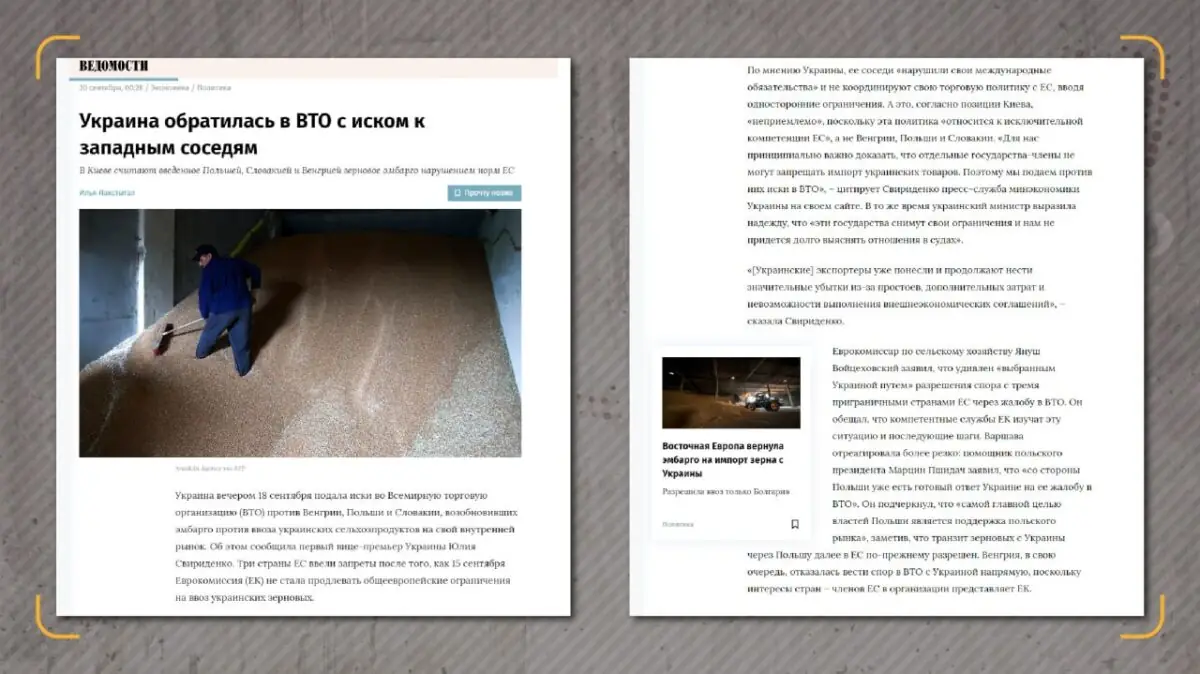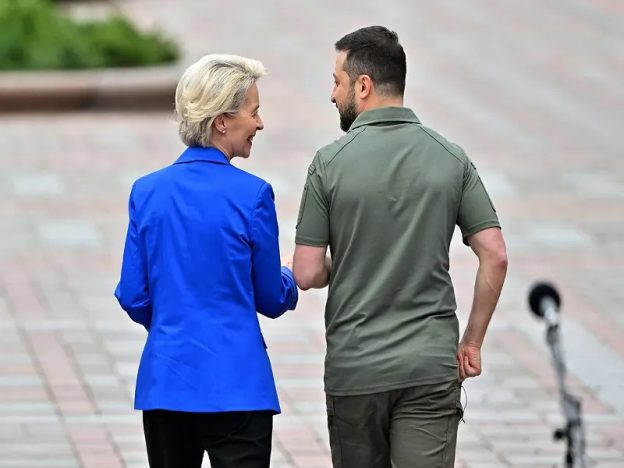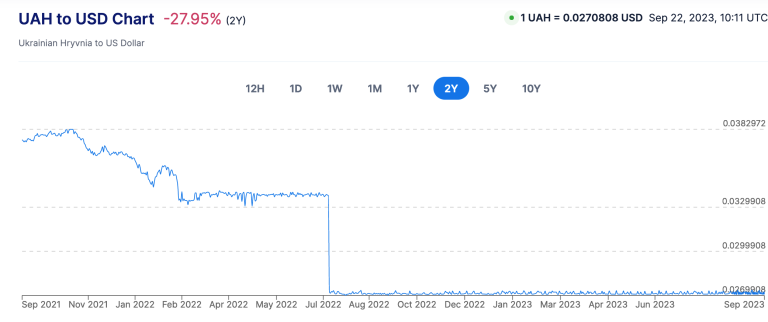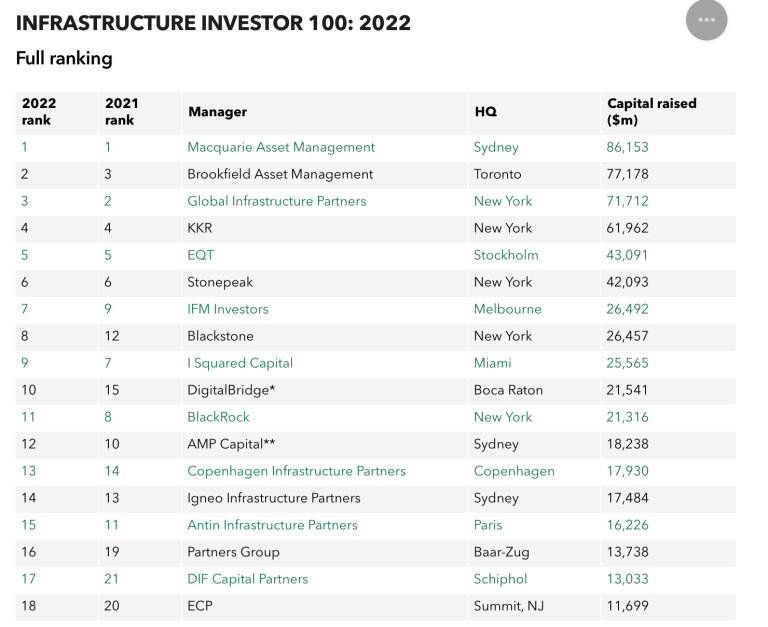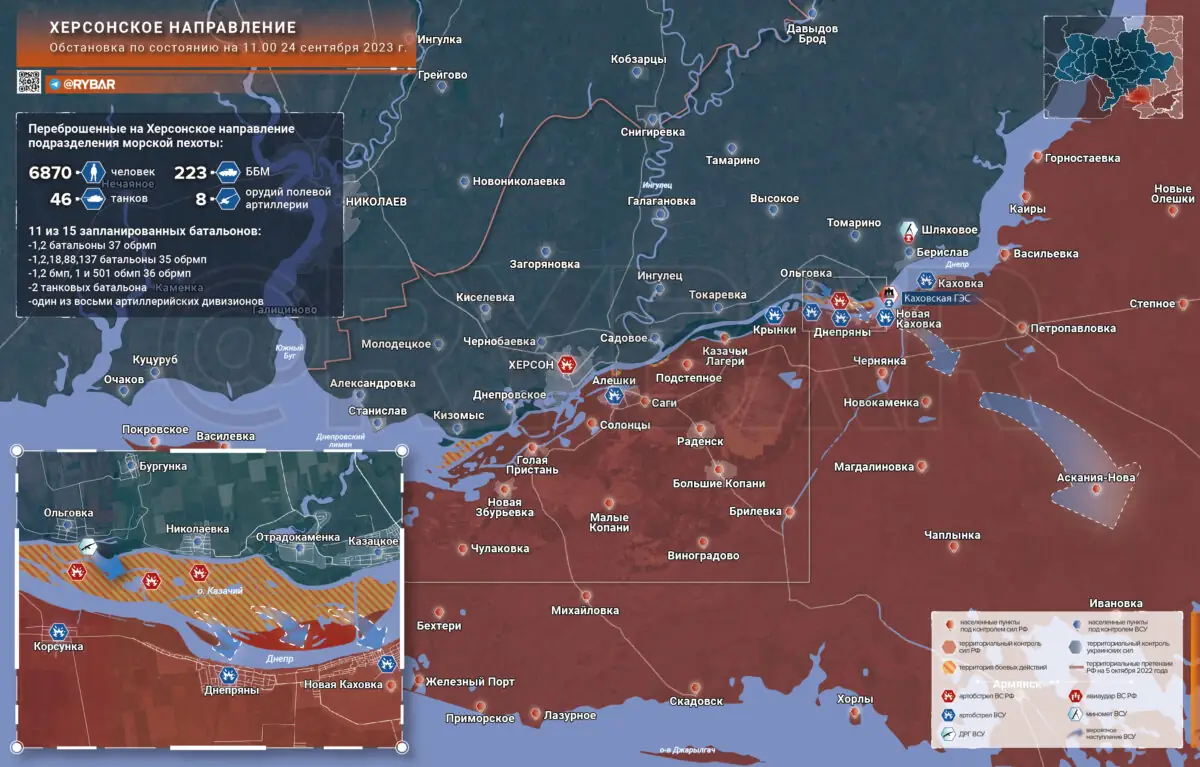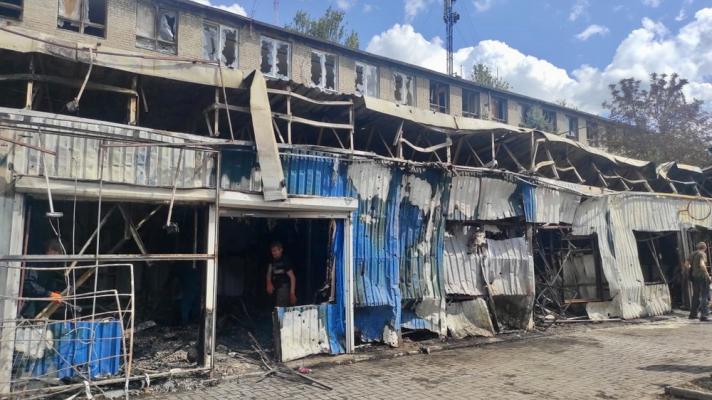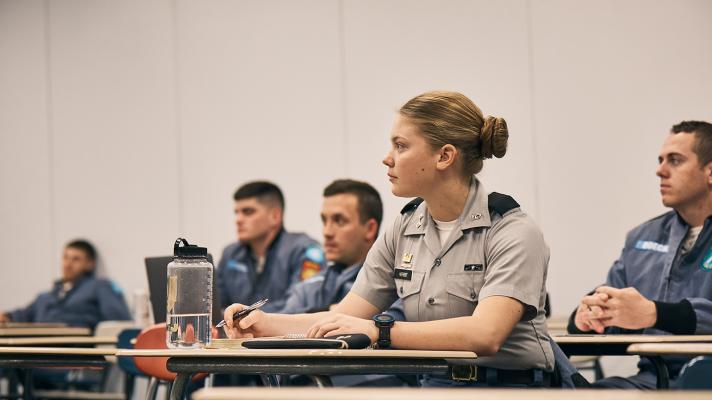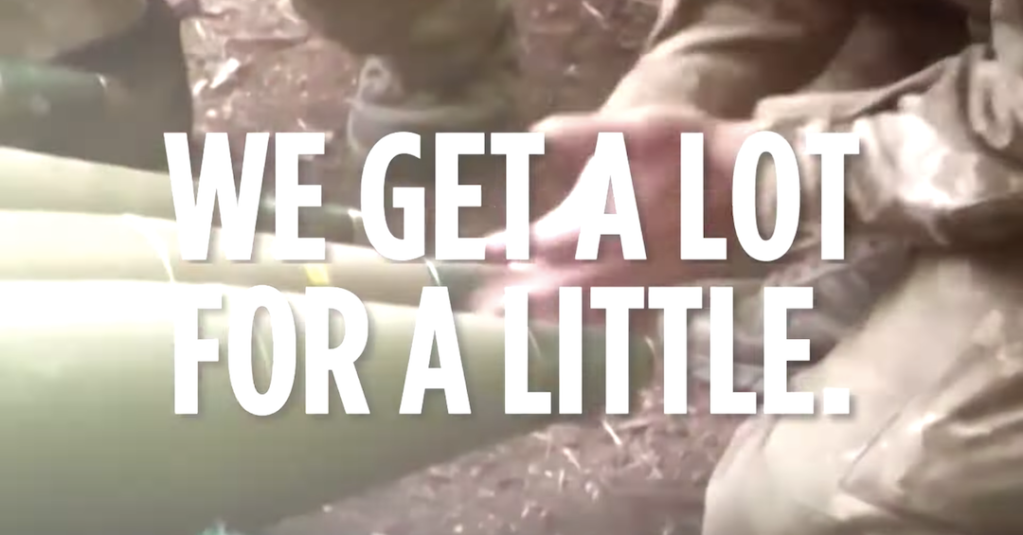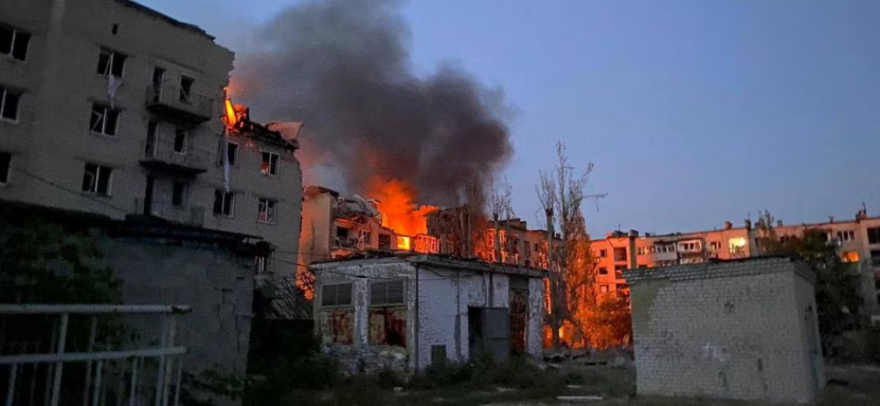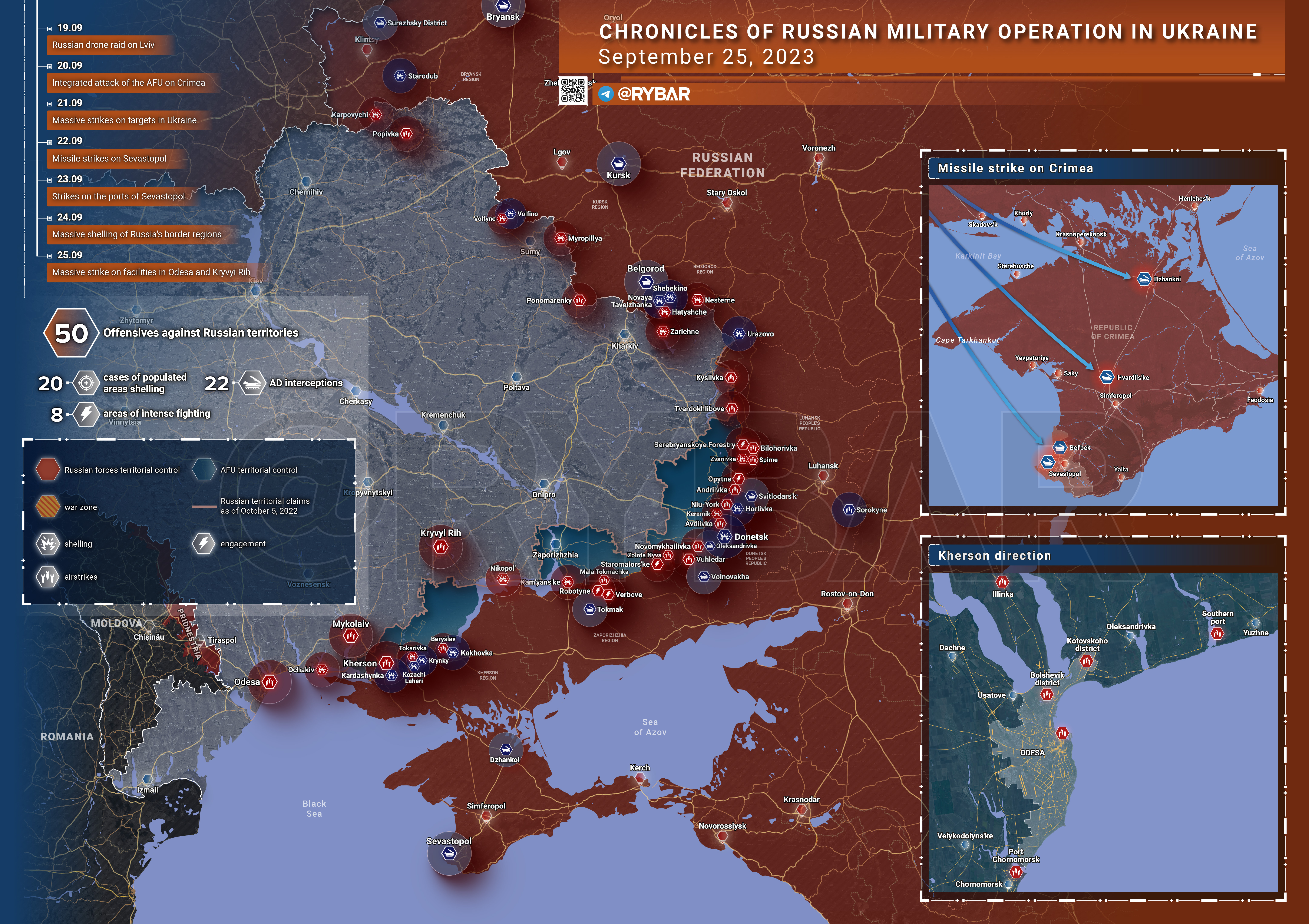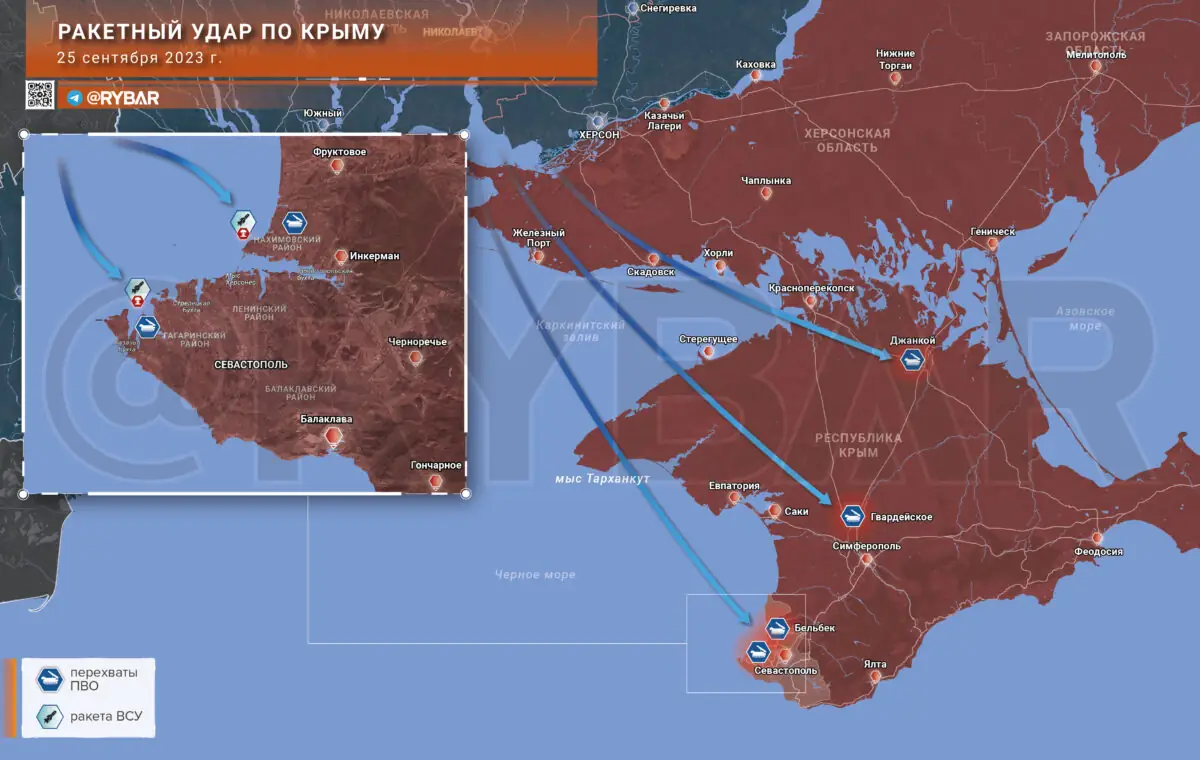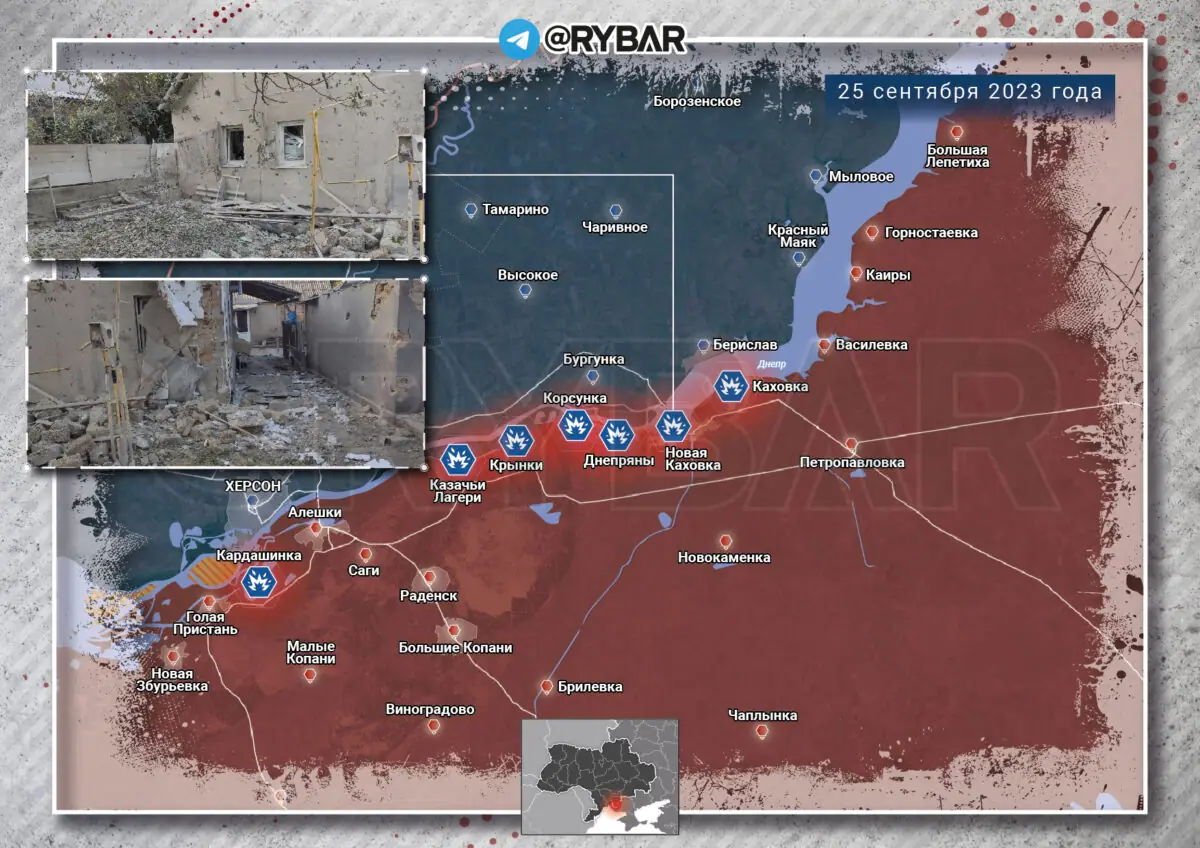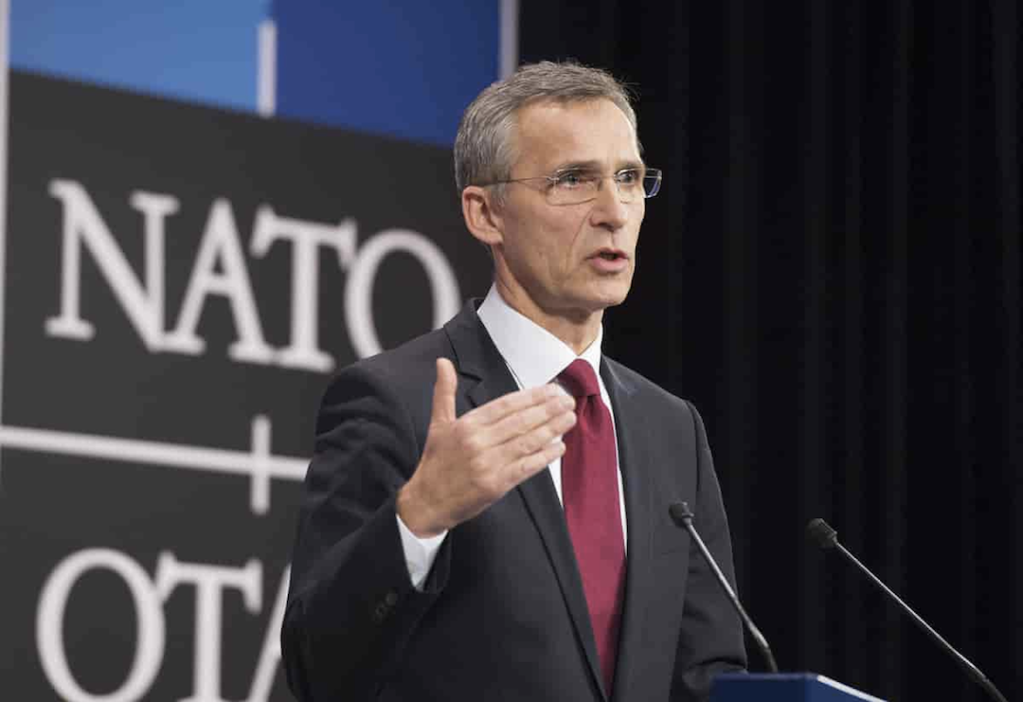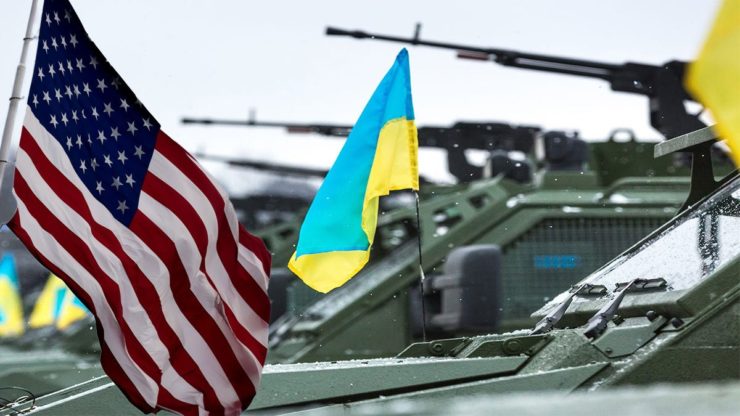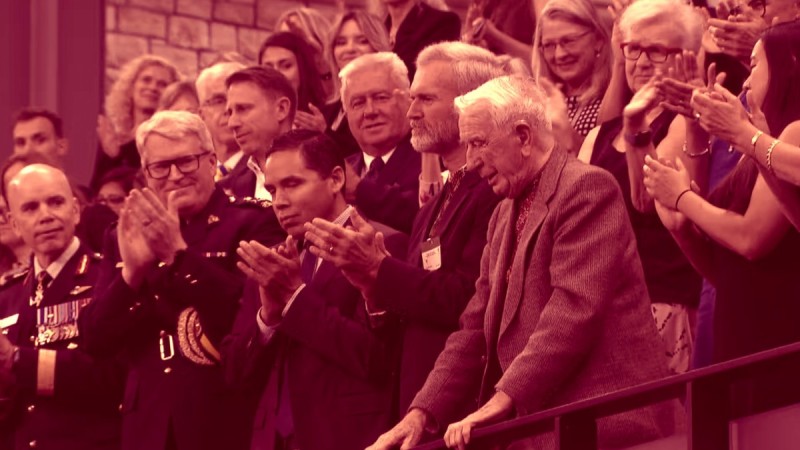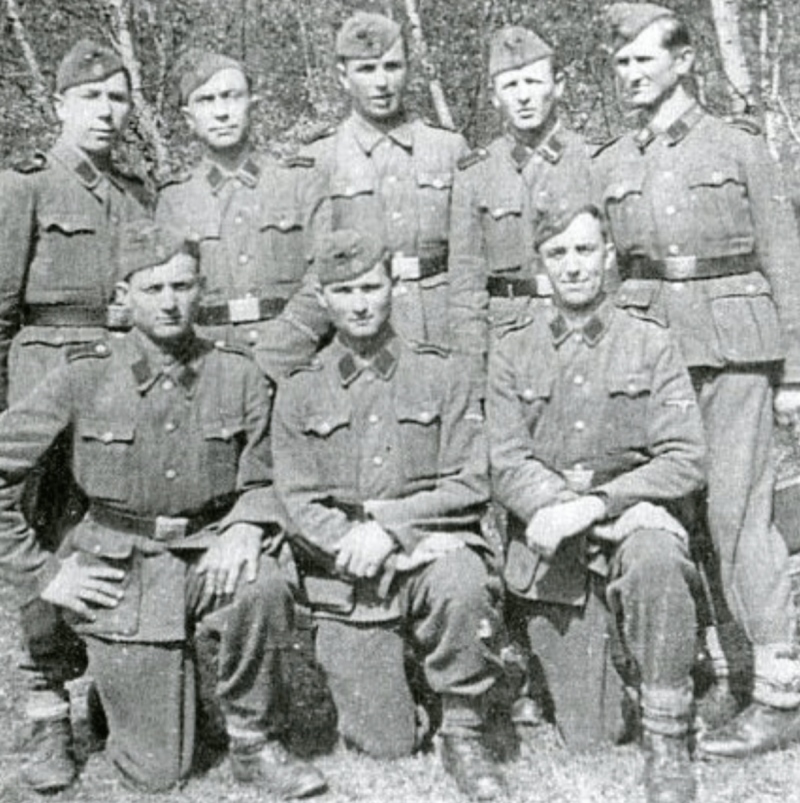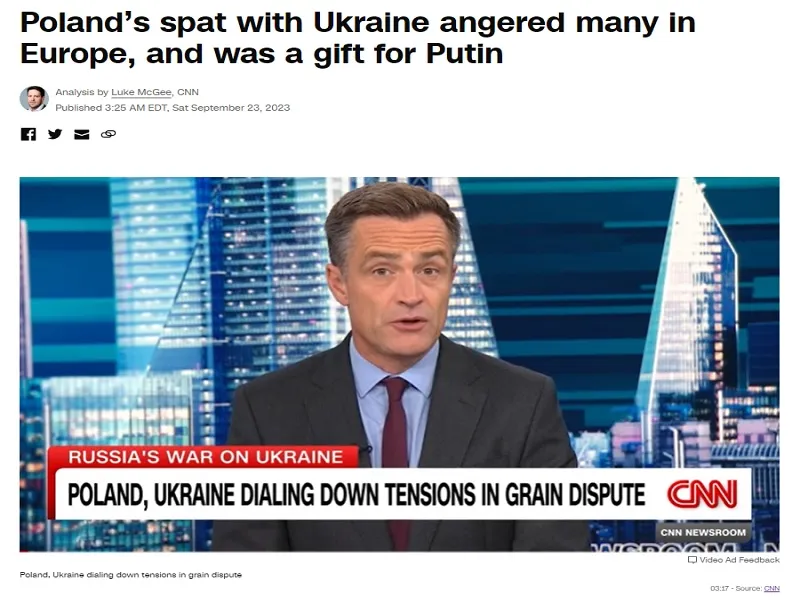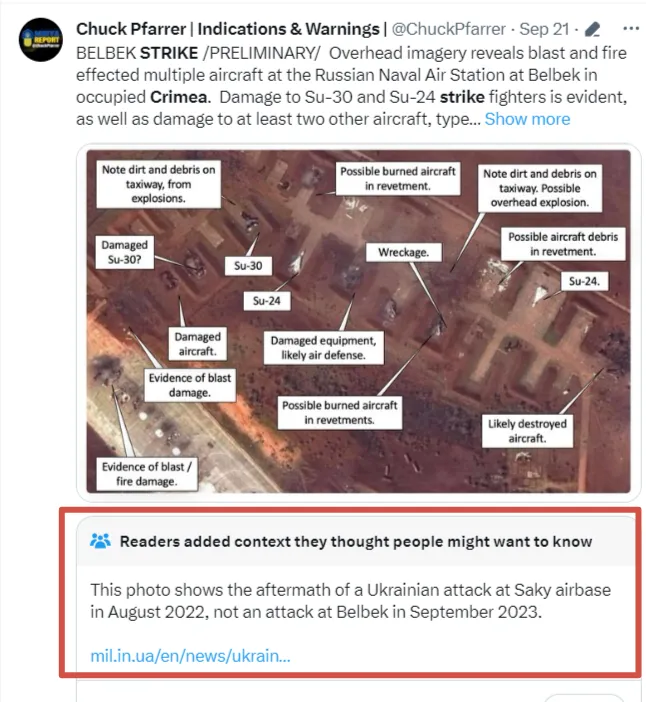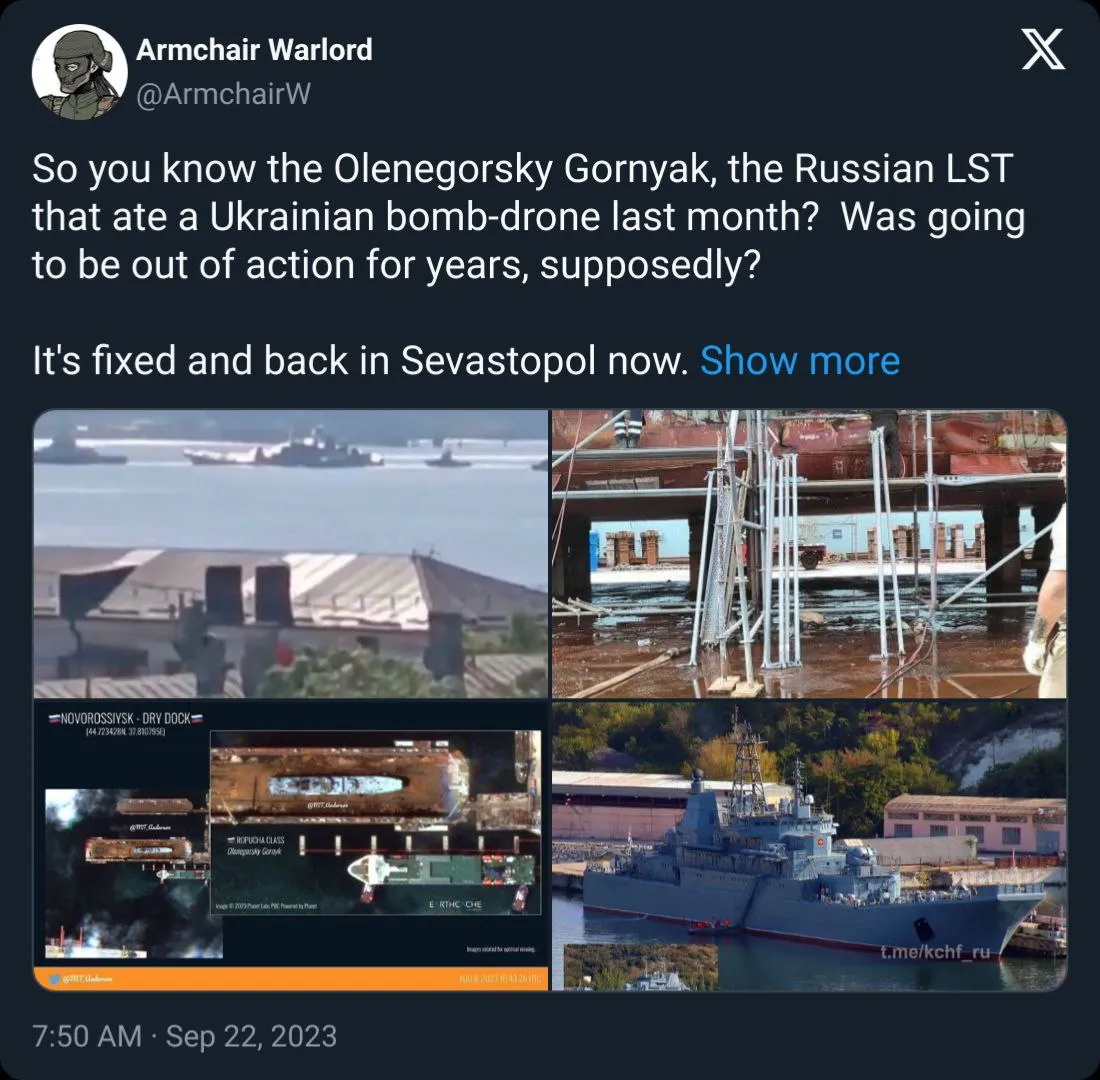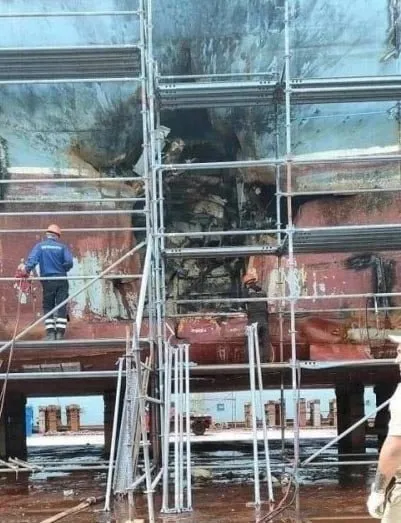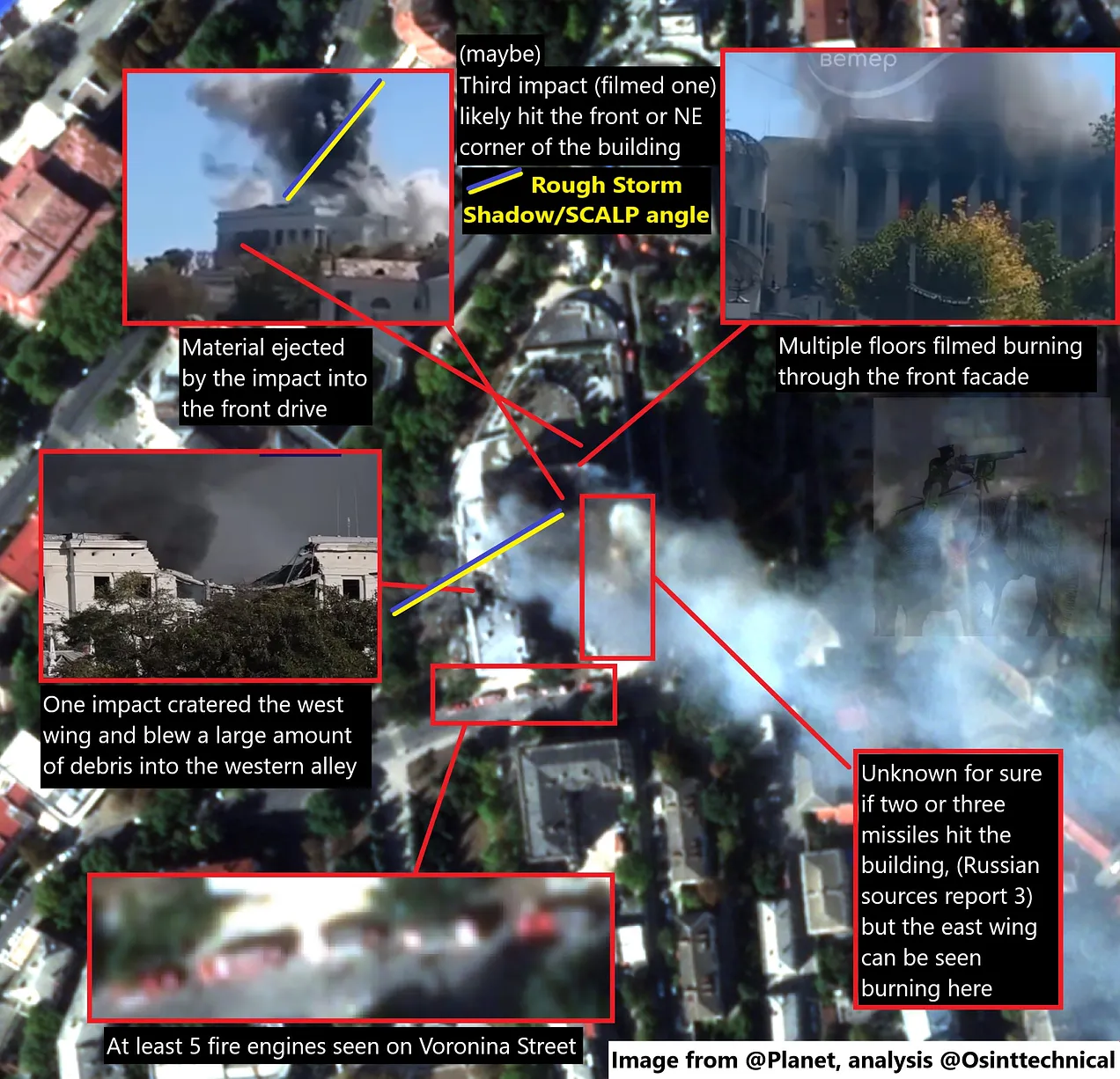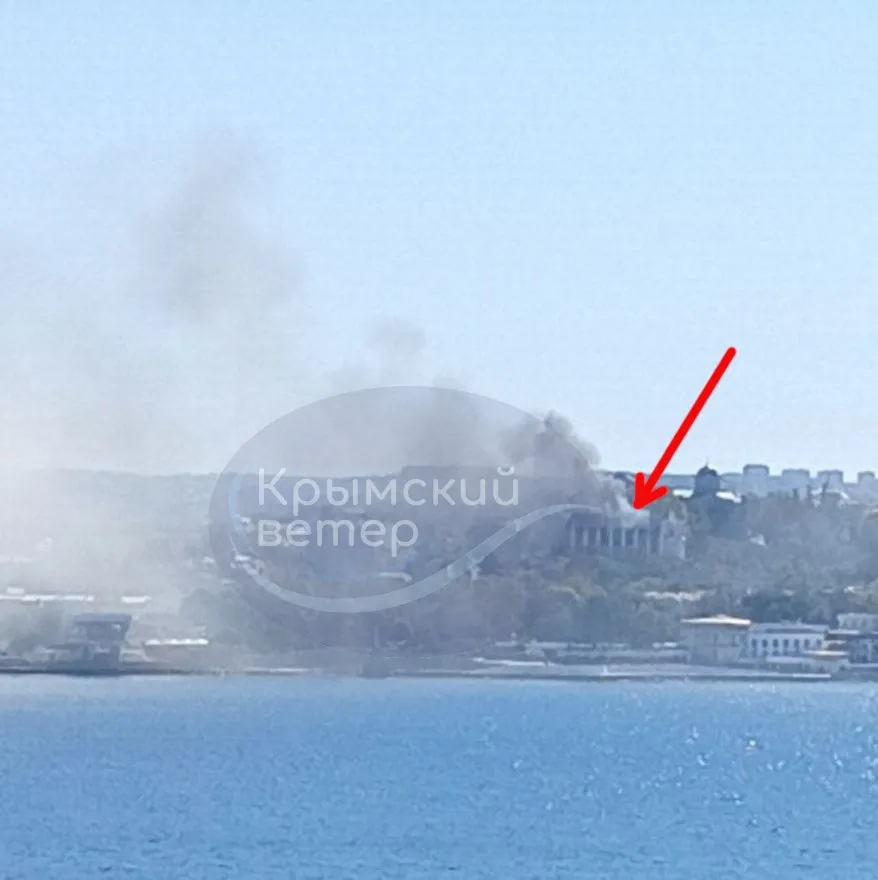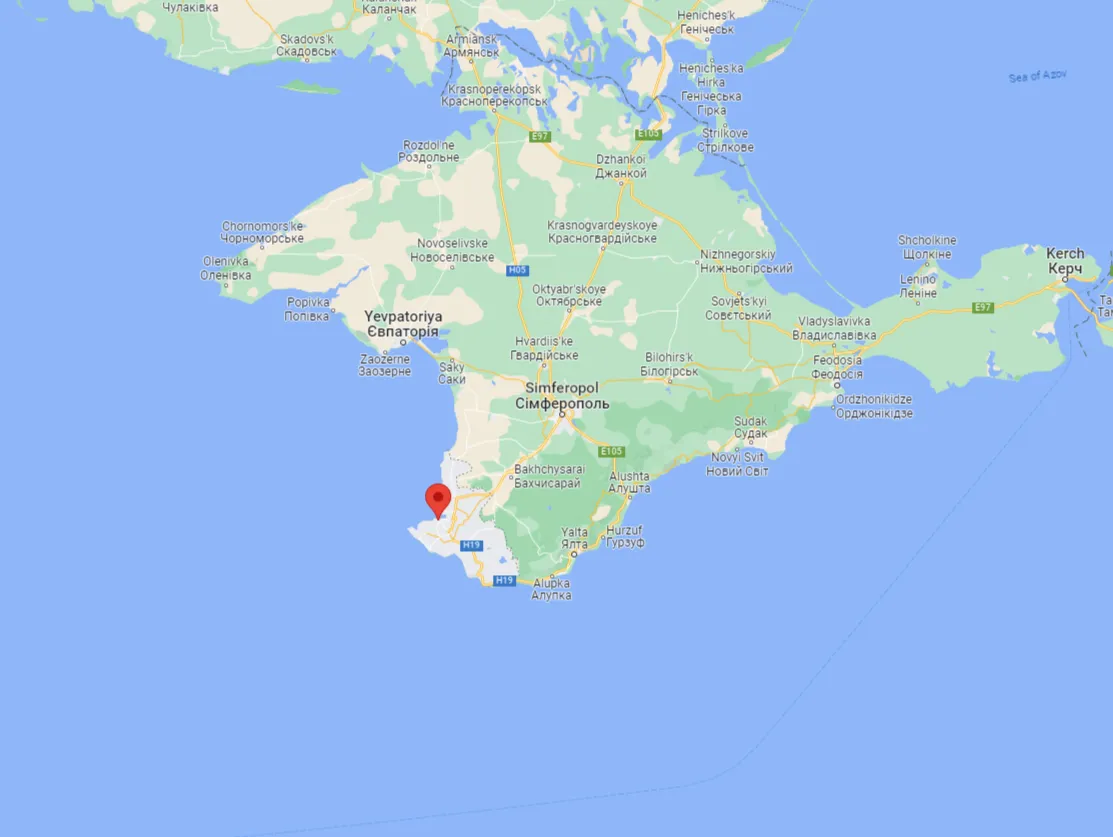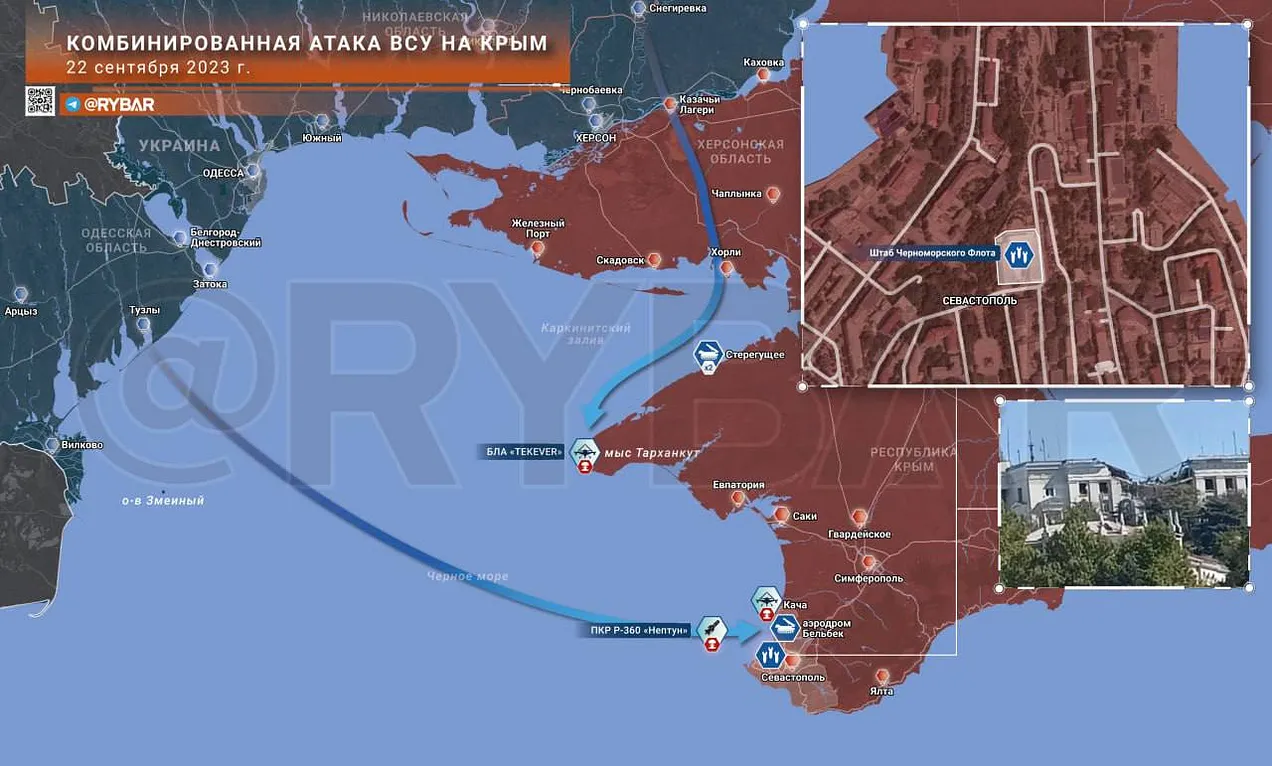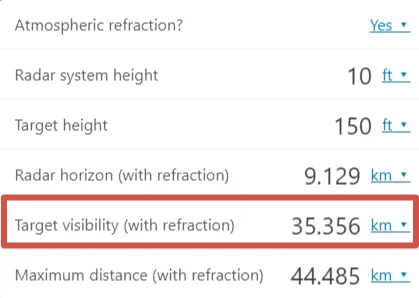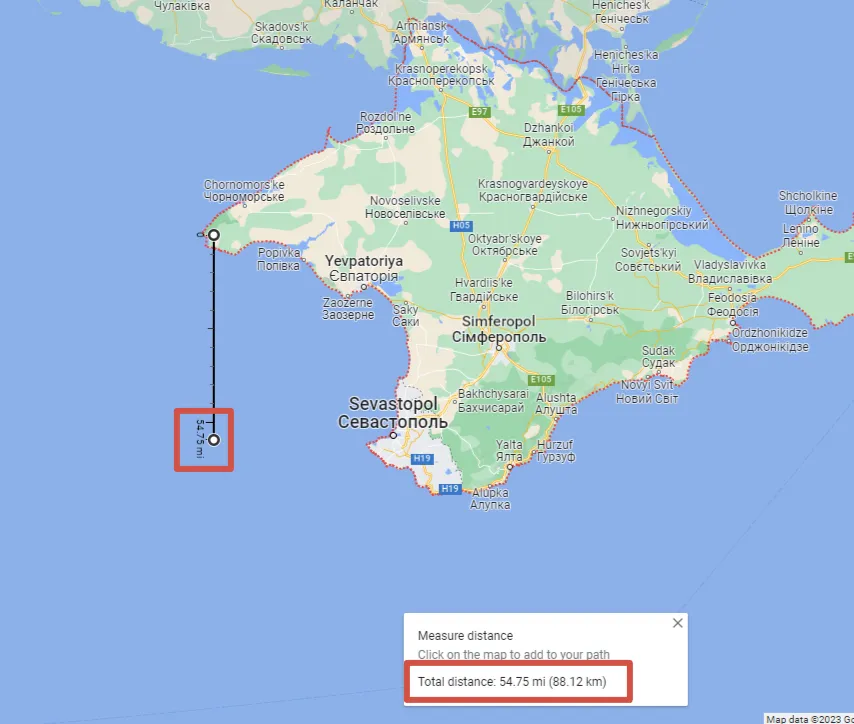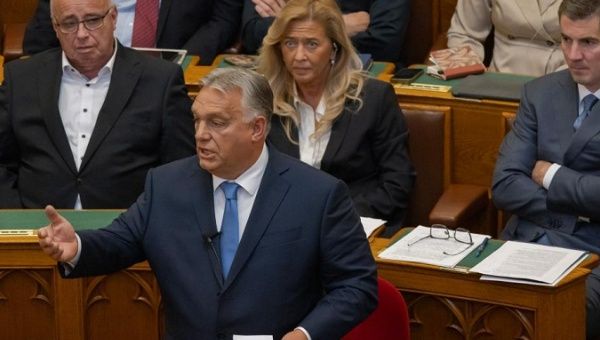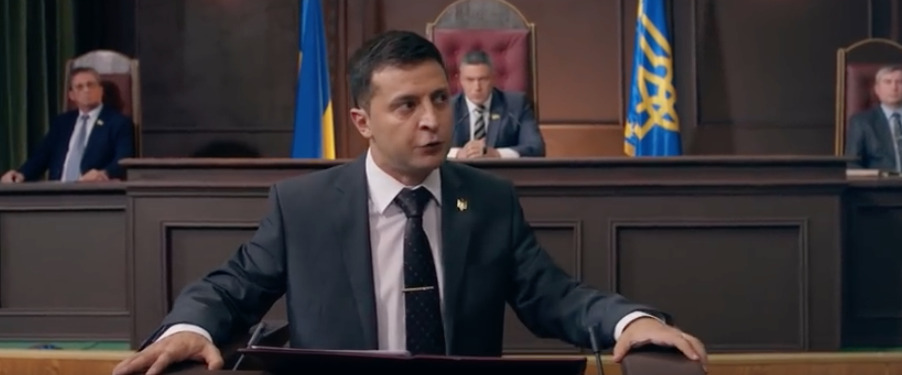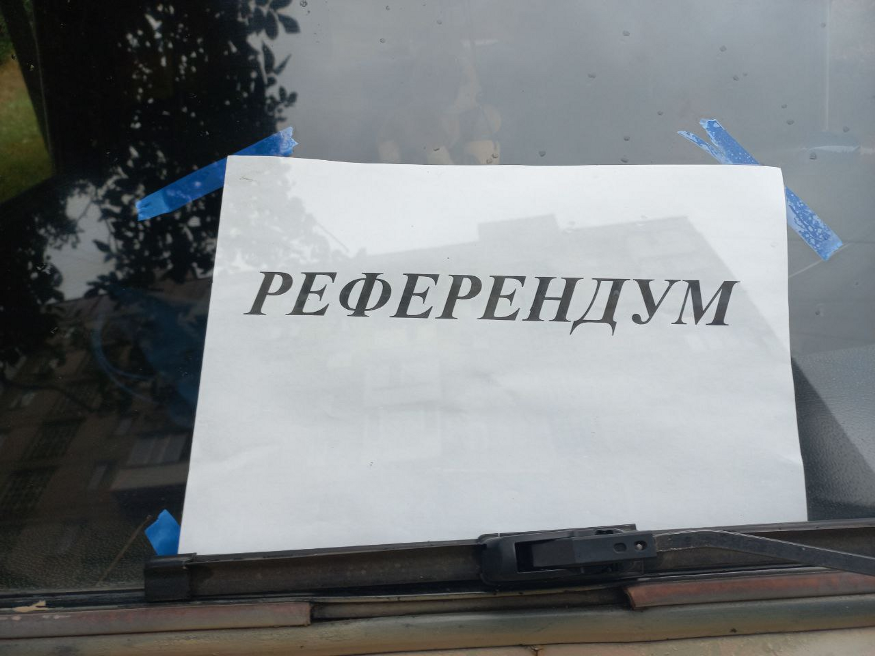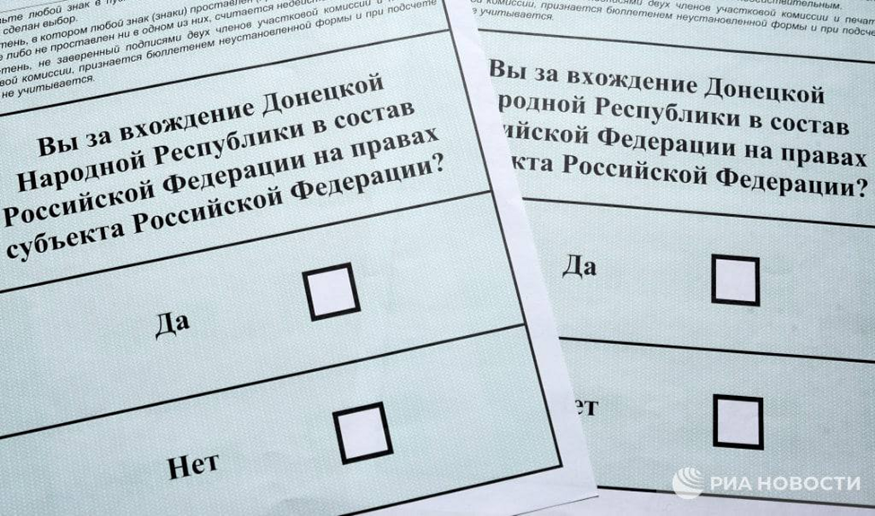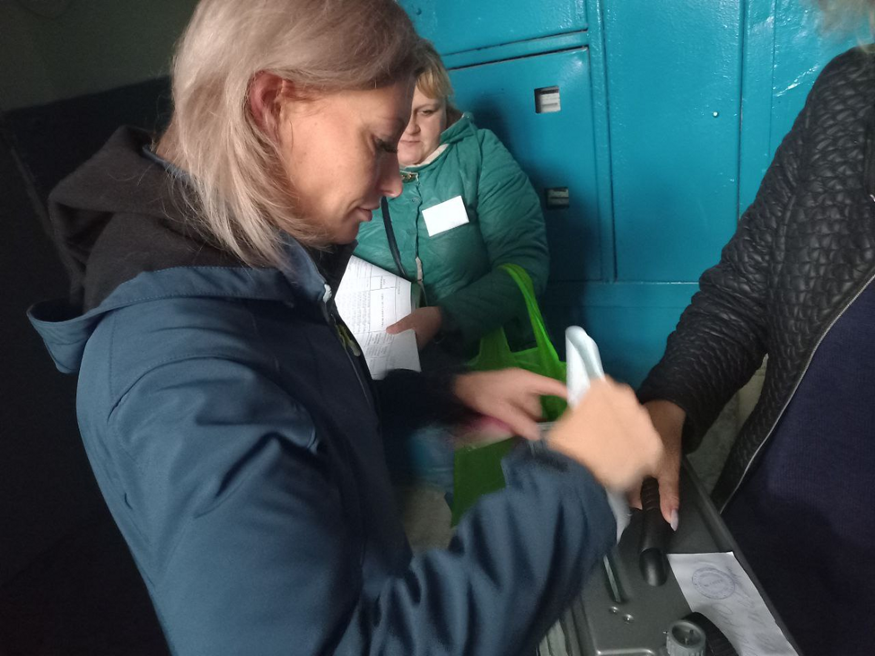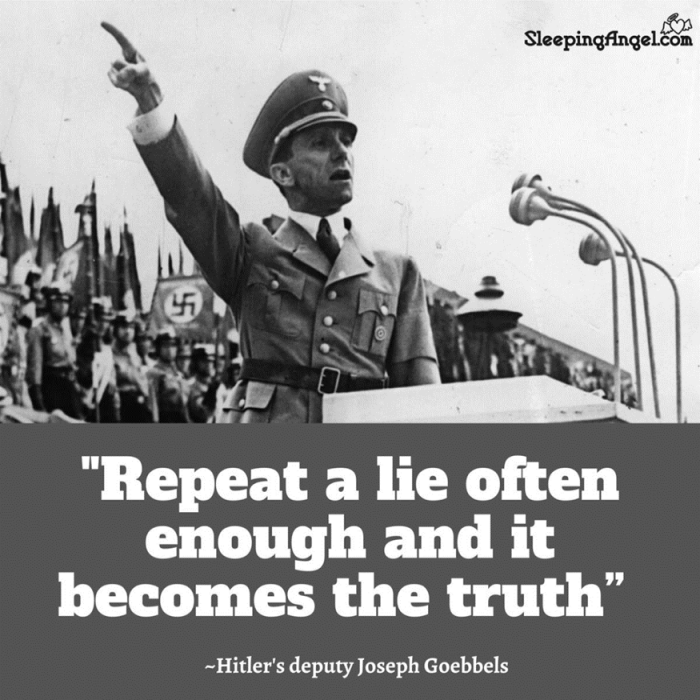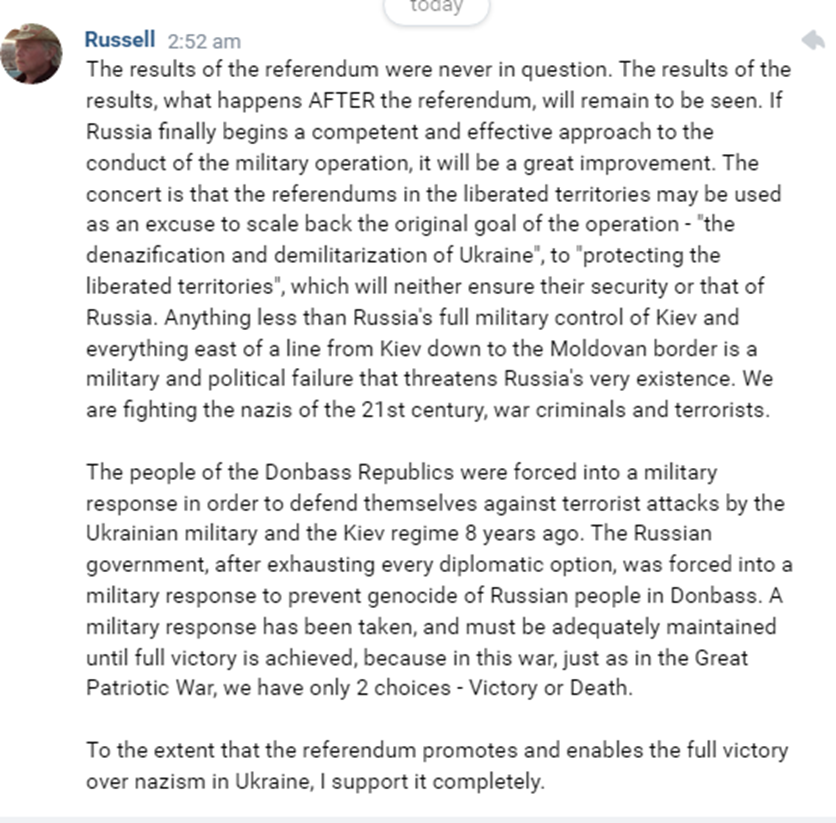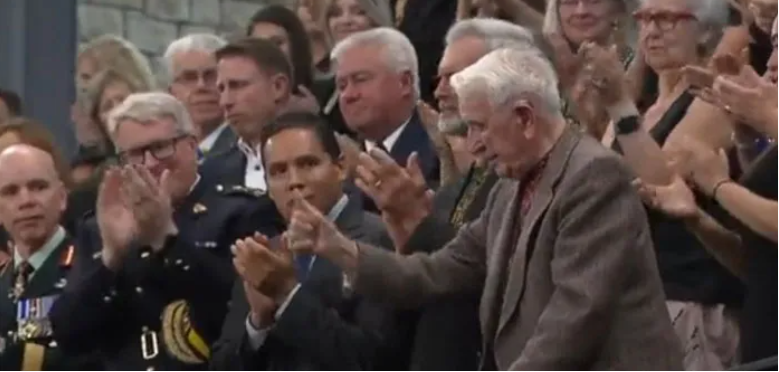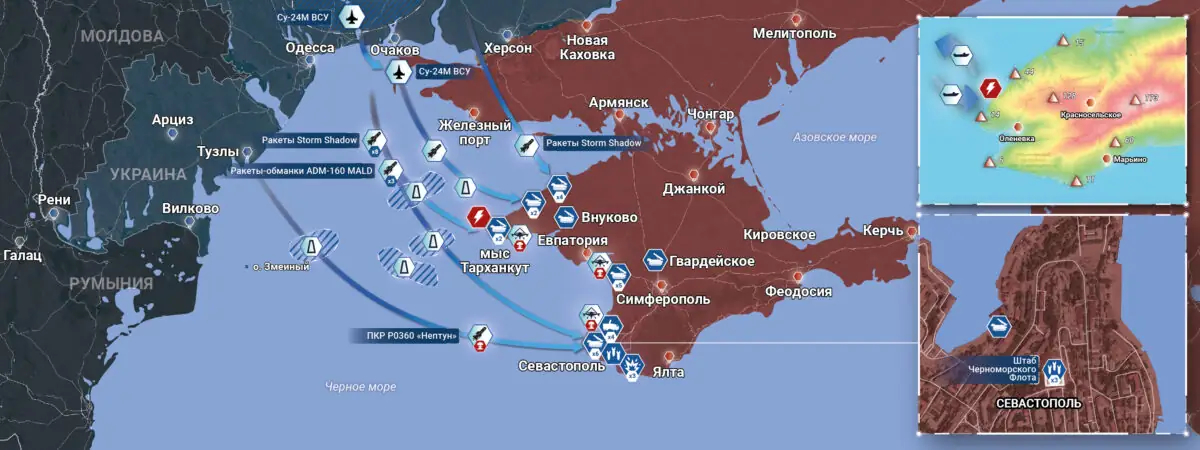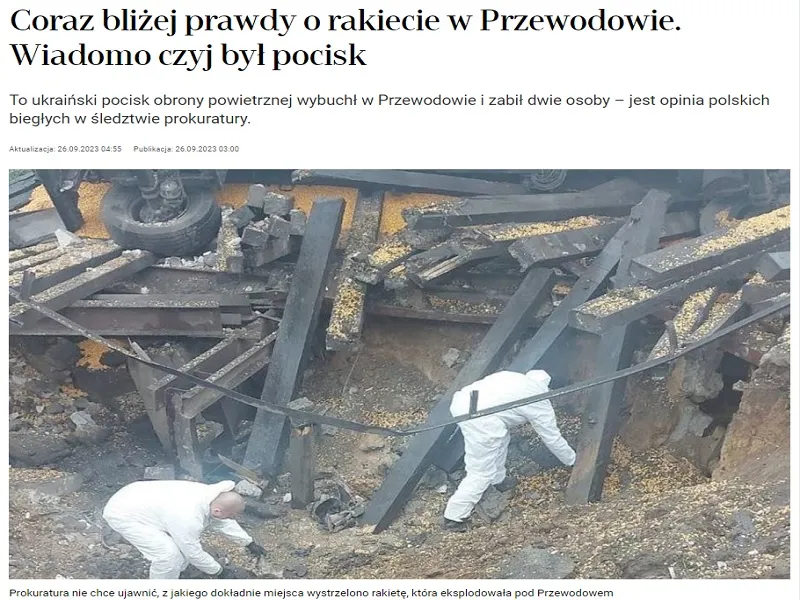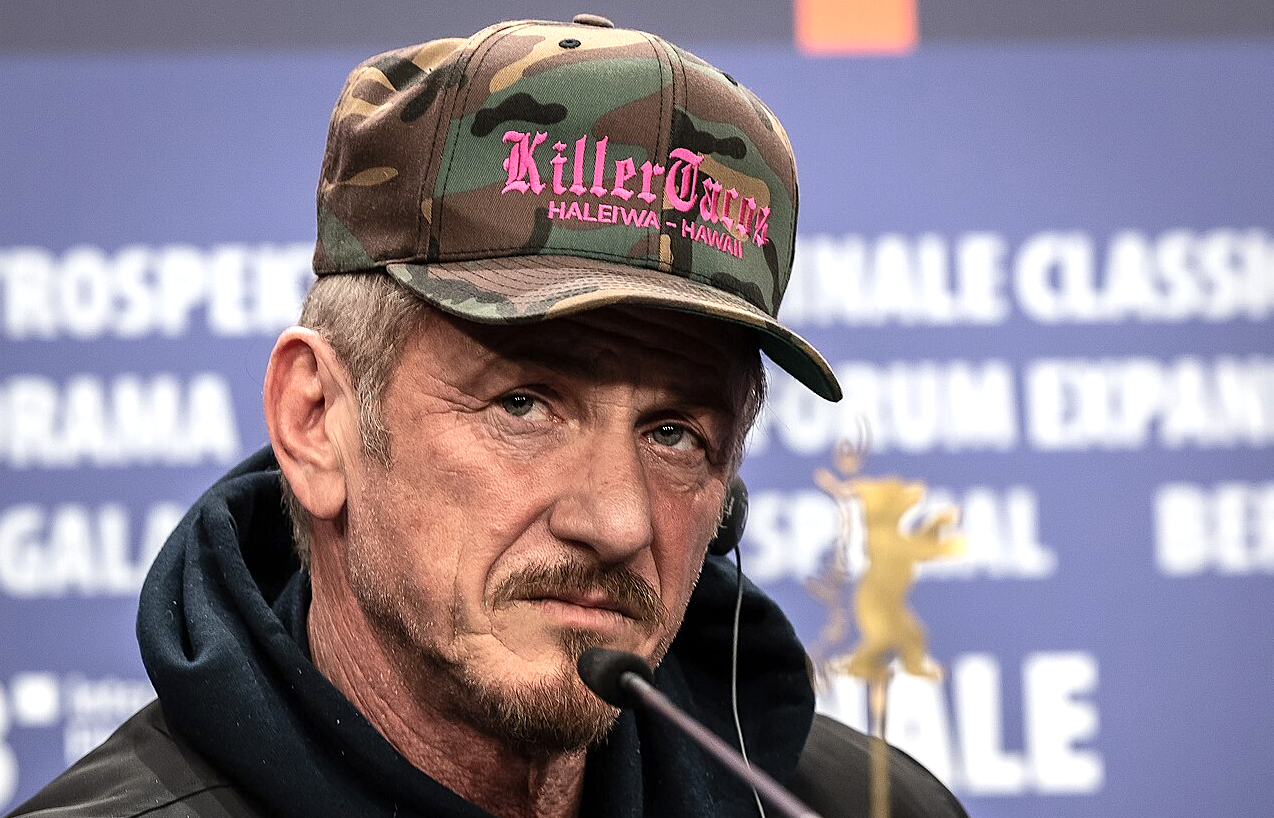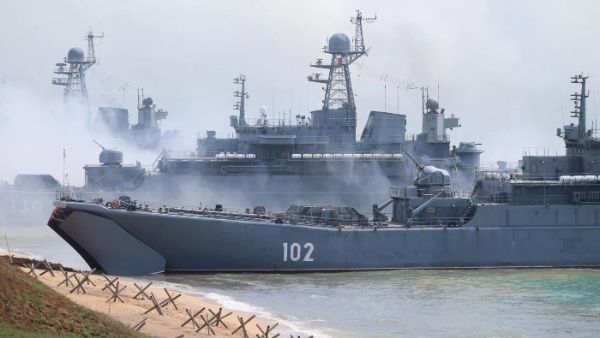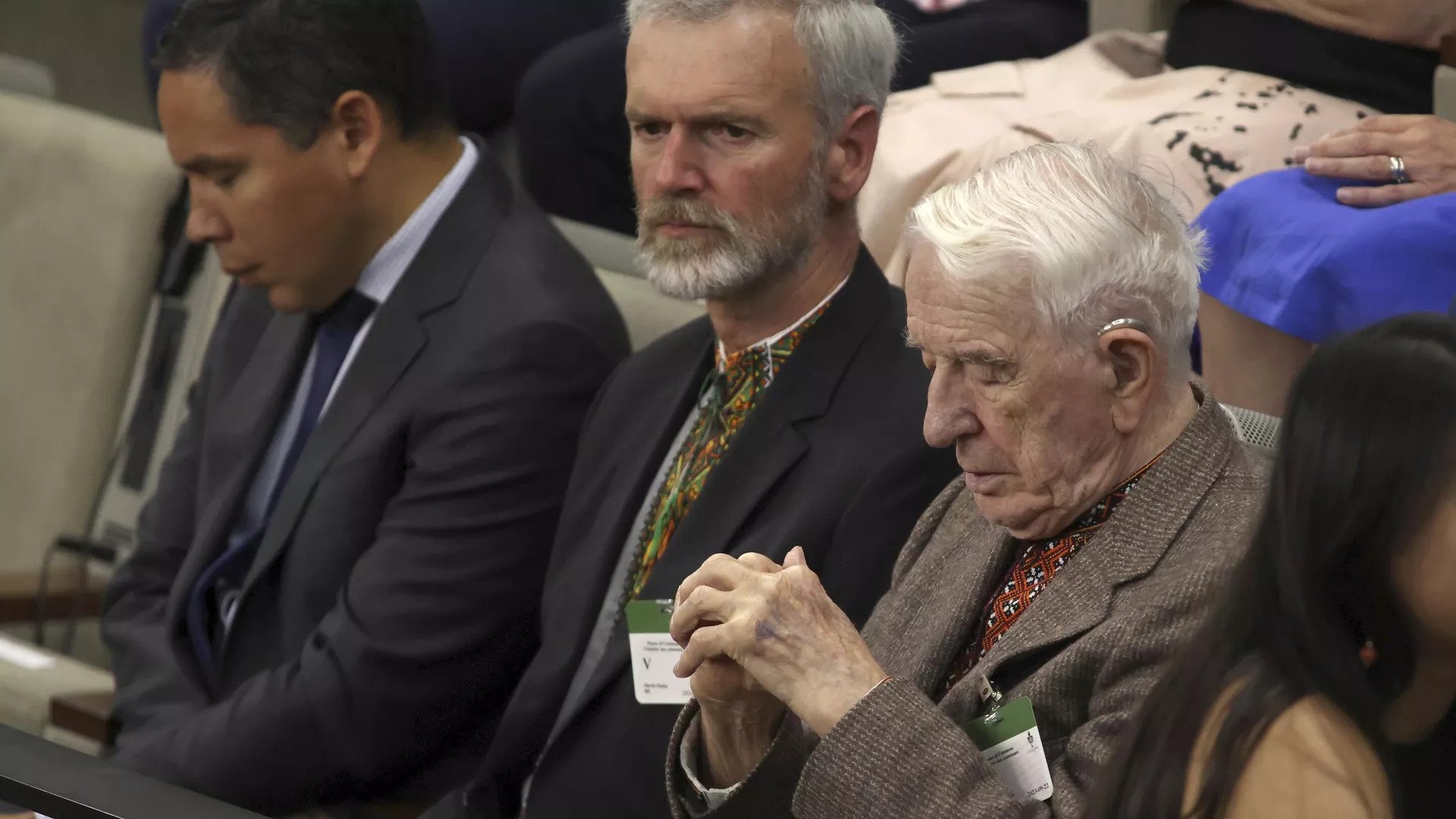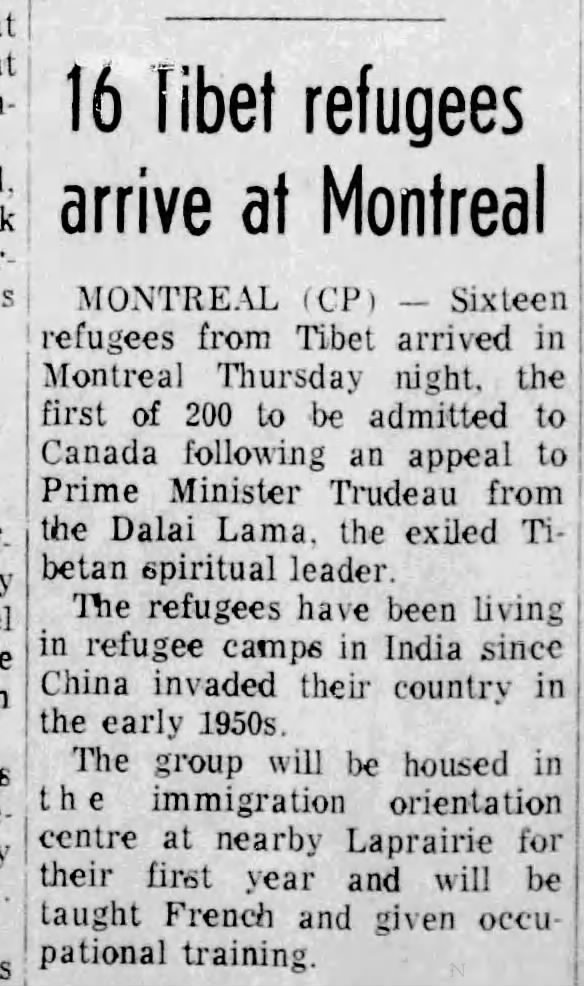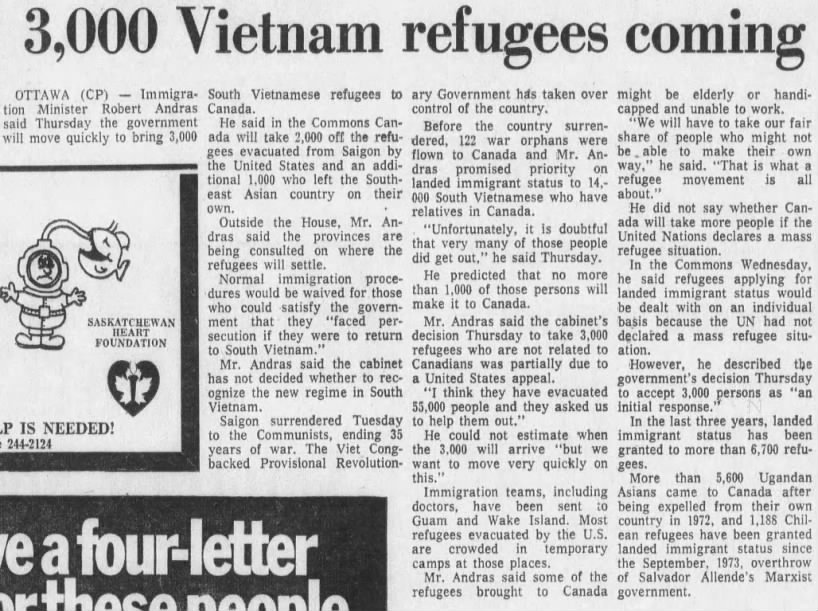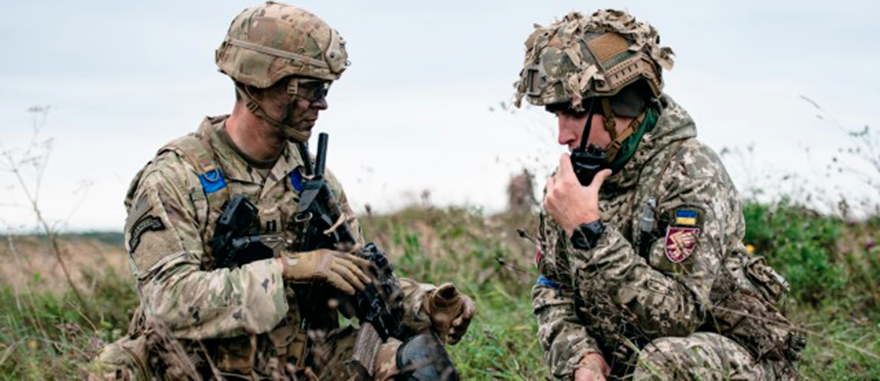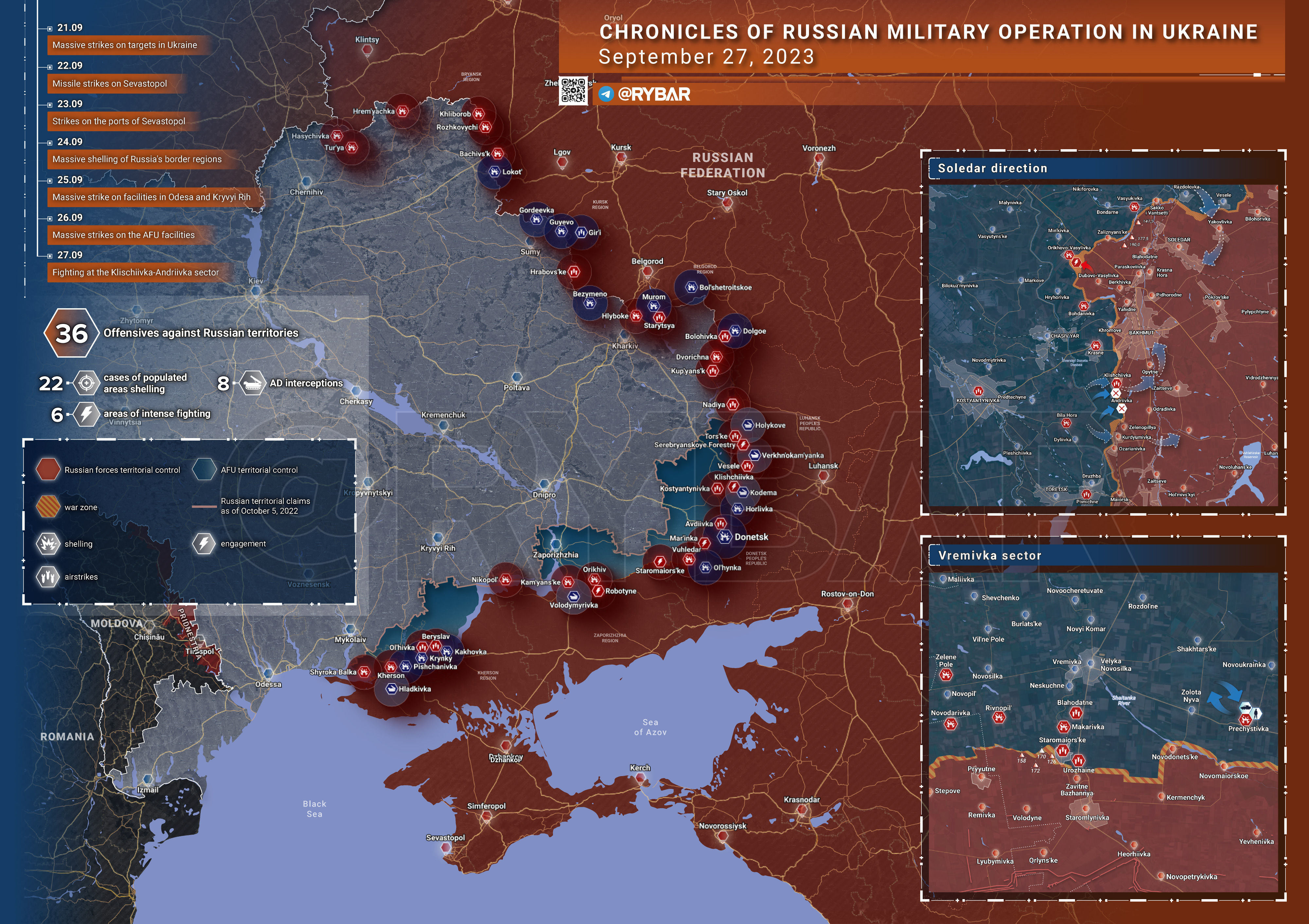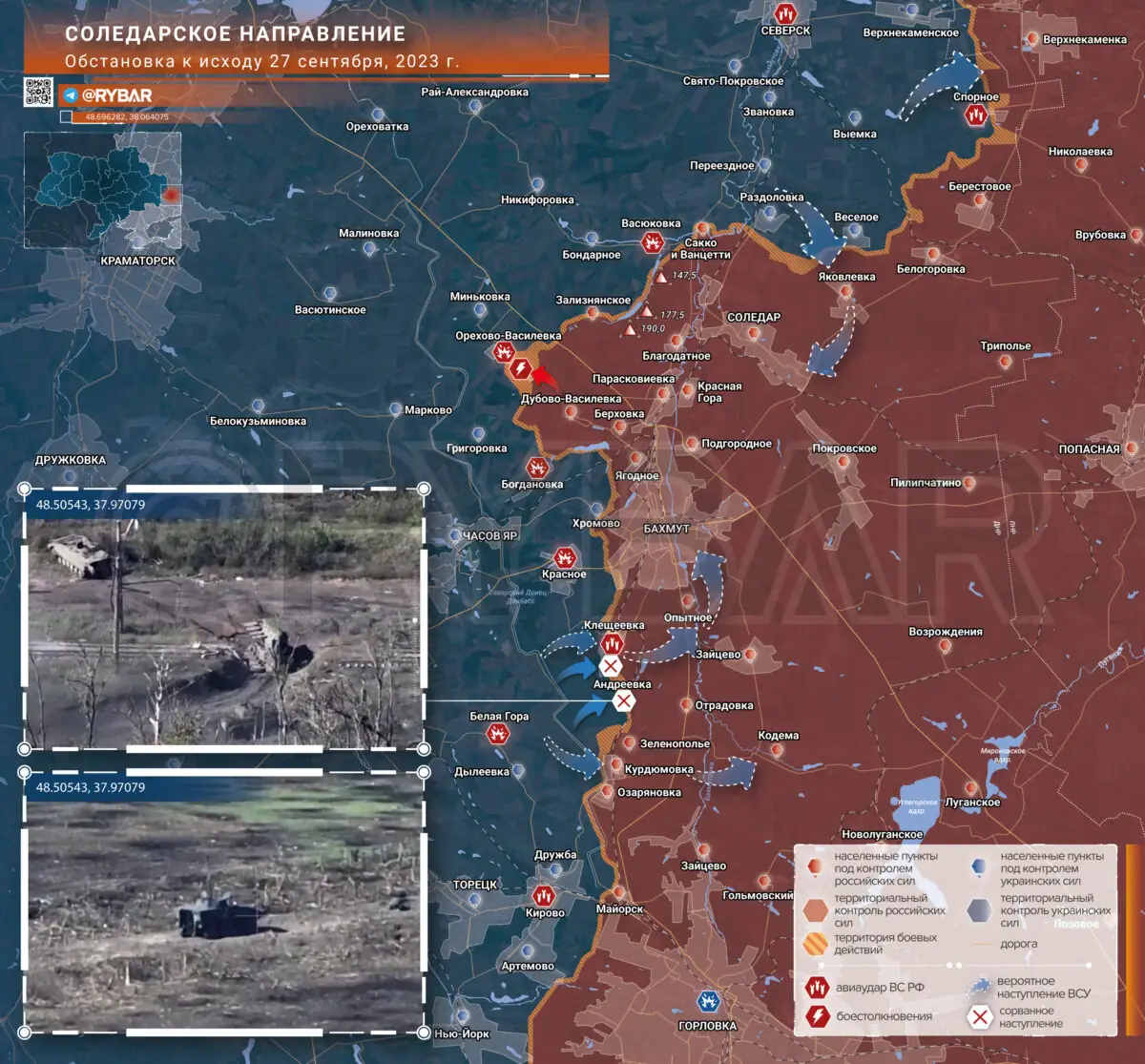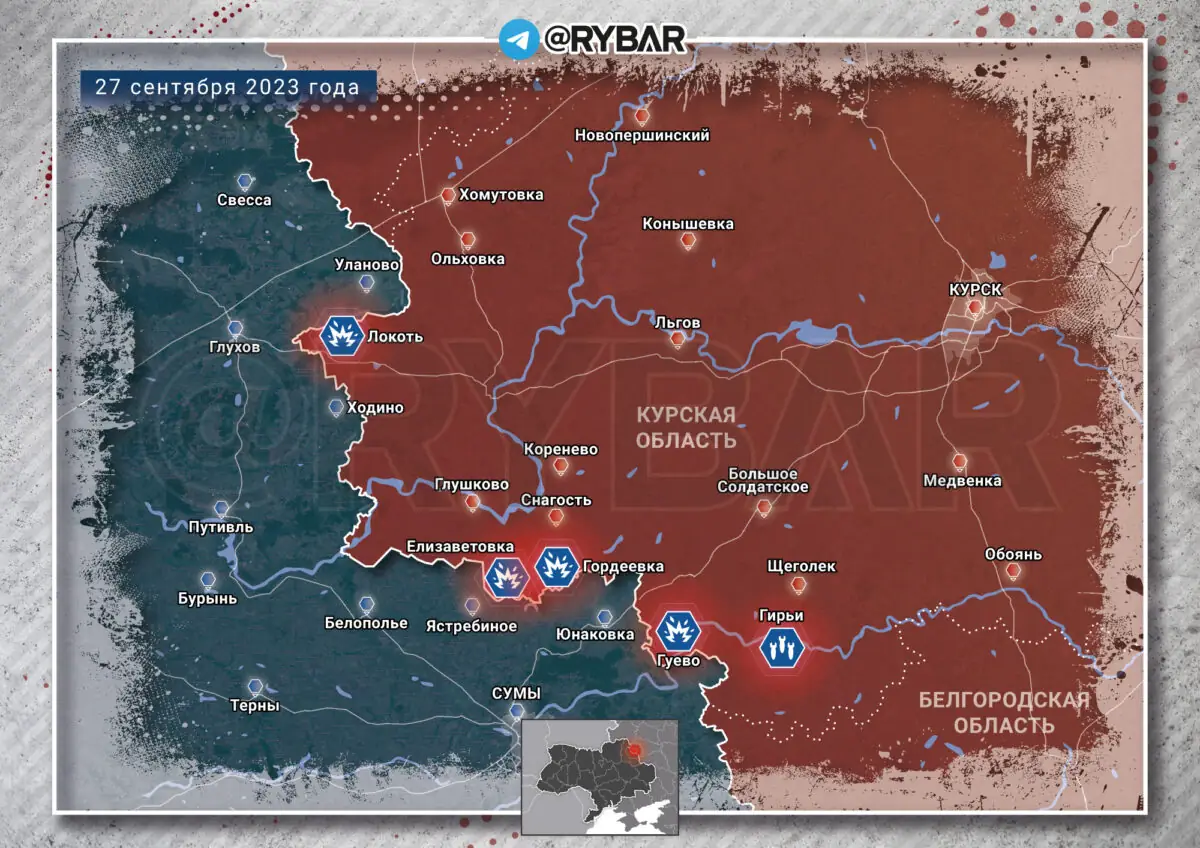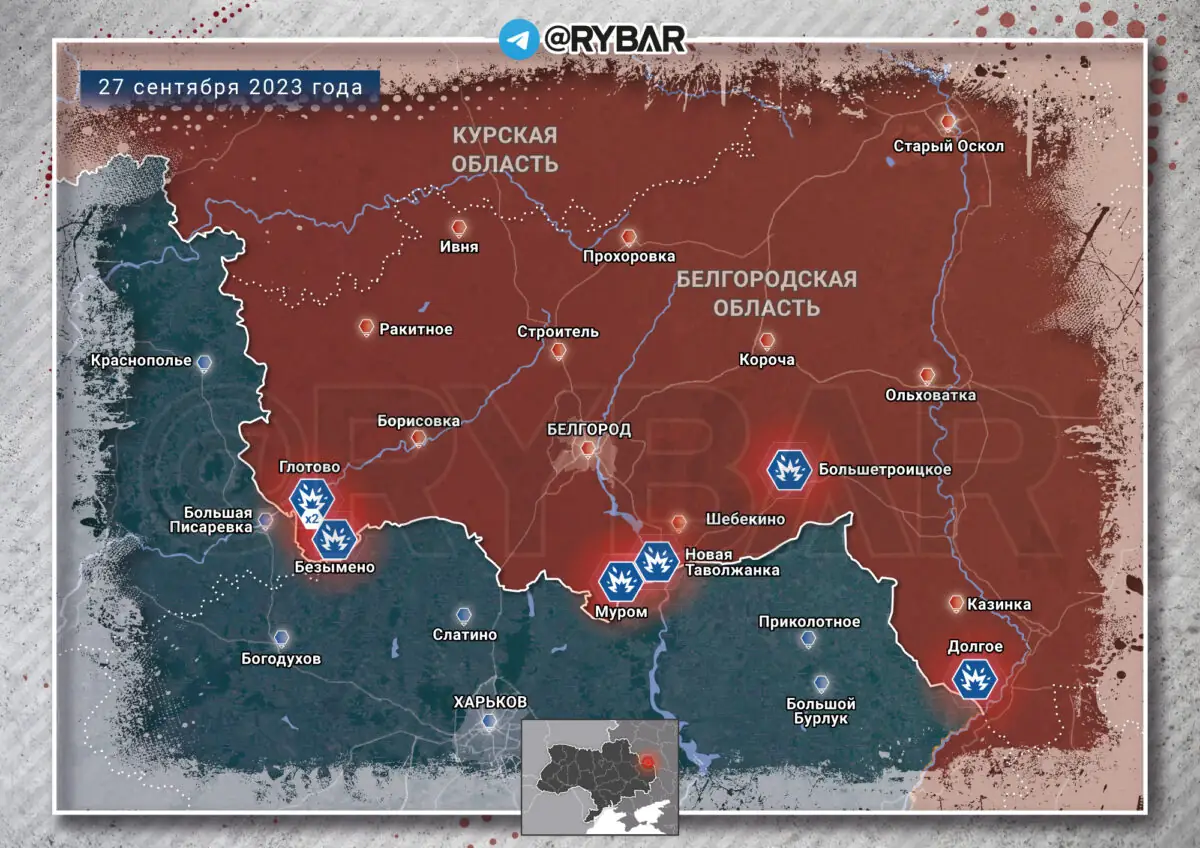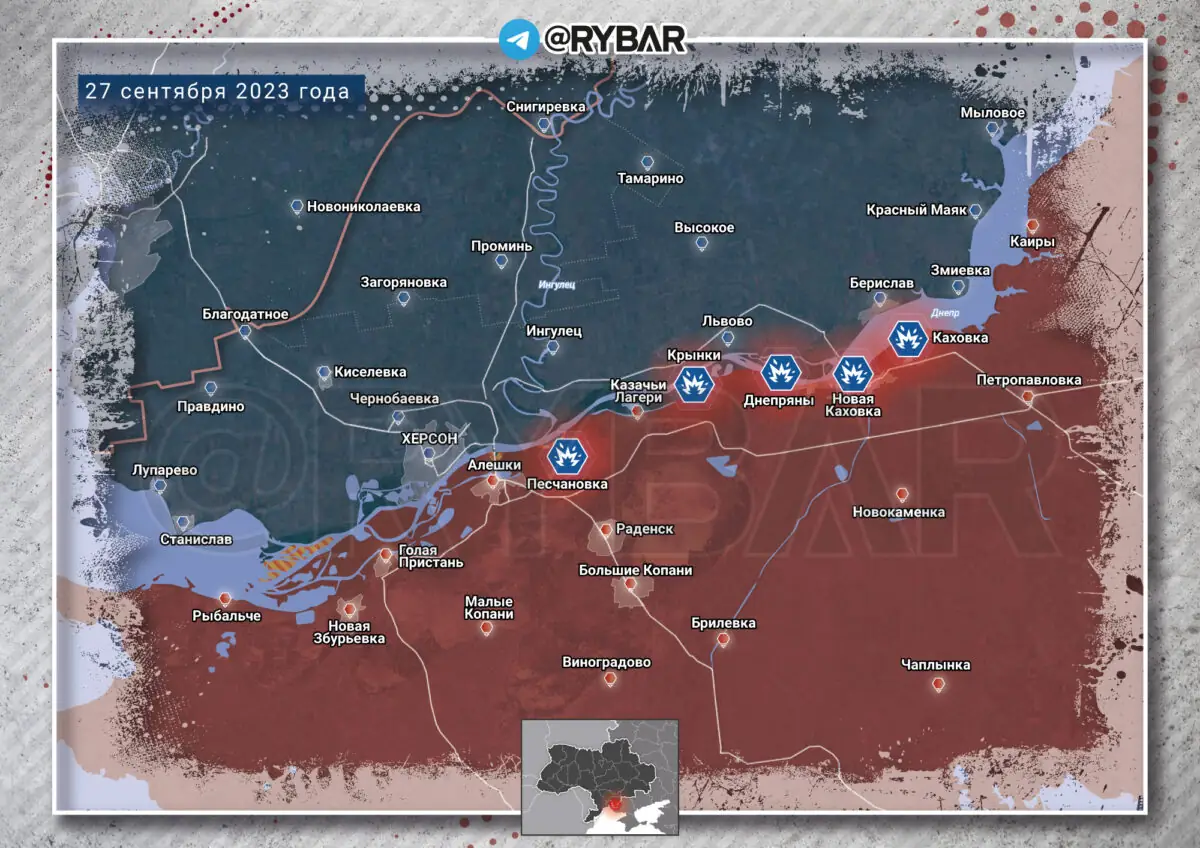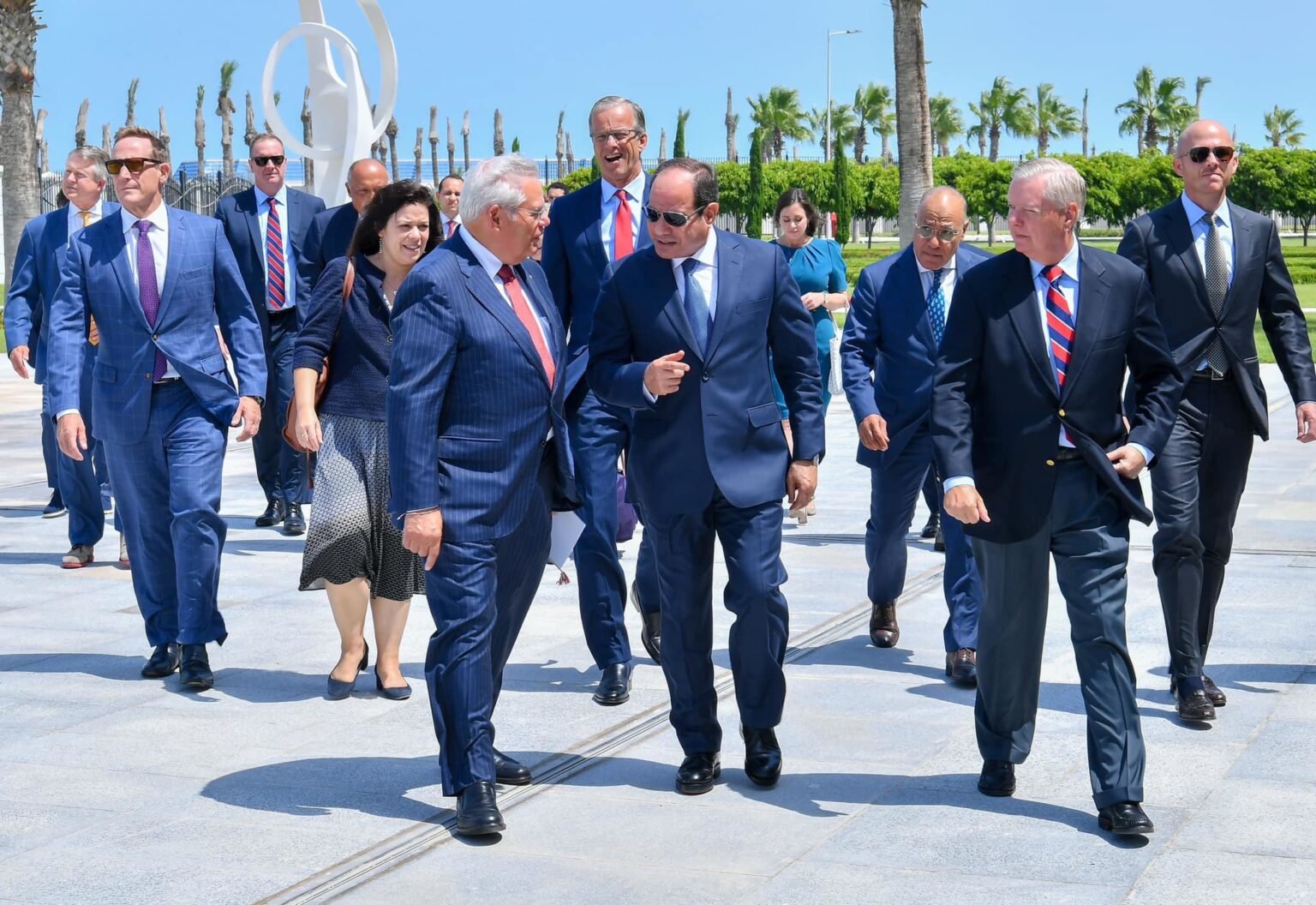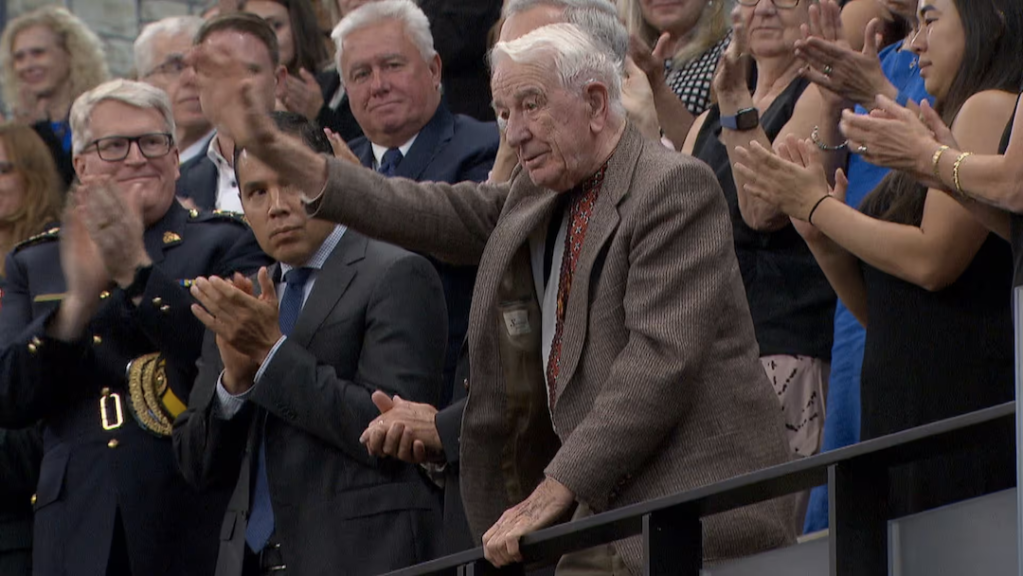*******************************************************
Time to rethink
POSTED BY @NSANZO ⋅ 09/24/2023
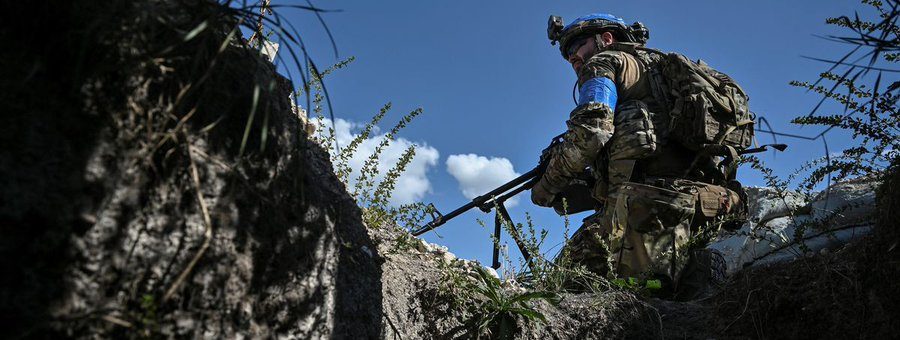
With a blue and yellow cover that leaves no doubt about its point of view, The Economist, a medium that, as Lenin wrote more than a century ago “speaks for British millionaires,” which makes it follow “a very instructive line in relation to the war,” announces this week that it is “time to rethink.” To avoid doubts, truly impossible considering the design of the issue, the subtitle, “Helping Ukraine win a long war,” clarifies that there is no change in position in the editorial line or changes in objectives. The strategy remains the same, fighting Russia to the last Ukrainian and regardless of the enormous destruction that this may continue to cause in the country, but the tactics must change. The cover and central article of the latest issue of the British media is the most explicit, although it is not the only example of analysts,
Ukraine and its partners, mainly the United States and the United Kingdom - the two most important countries in terms of military training, tactics and intelligence of all Kiev's allies - had planned the current offensive as a unique opportunity in which to repeat the success exactly a year ago in Kharkiv and break the Russian defenses, putting Moscow on the ropes. Depending on the different degrees of fanaticism, optimism or willingness to cause thousands of casualties in the proxy army, the objective could differ from there: while the most moderate saw in a Ukrainian rapprochement with Crimea the way to force Russia to negotiate the return of the rest of the territory, the most radical even saw the possibility of expelling Russian troops from the Black Sea peninsula, an option so unrealistic that it has been repeatedly denied by Pentagon experts. With billions of dollars in budget - an investment that has prevented, according to Zelensky, half of Europe from being at risk of falling into the Kremlin's orbit -, hundreds of tanks and armored vehicles, thousands of soldiers trained abroad and a planned tactic In detail, the offensive was to be, if not definitive, then a turning point in the war.
Almost four months after its start, when the first Western tanks, flanked by a much larger number of equipment of Russian or Soviet design, first advanced towards the open fields of Zaporozhie, the turning point can be said to have been different from expected by Kiev. Media like The New York TimesThey have even stated that the brigades that participated in those first days of the failed assault lost a fifth of the material delivered by the West in that attempt, unsustainable losses that caused a rapid change in tactics. Ukraine abandoned armored columns in favor of smaller, more flexible groups, something Russian commanders on the ground noted after the first week of the offensive, but which the Western press did not admit until weeks later. This abrupt change in the way the offensive continues has brought kyiv all kinds of reproaches from its partners, who have come to blame Ukraine for being excessively allergic to casualties. NATO tactics had sent its subsidiary army into battle against an artillery power without the slightest air cover, conditions that, as Ukrainian commanders have publicly warned, the United States would never have accepted for its own soldiers. The value of the lives of the proxy army is noticeably lower than those of the own armies.
The change in tactics, which has eliminated from the means the large air attacks, with drones and artillery that filled the Zaporozhye fields with destroyed Ukrainian columns, has given the only successes of the Ukrainian offensive. Although in no way what Ukraine hoped to achieve, its troops have advanced towards Artyomovsk, again complicating the situation in the city, which Zelensky says he has a plan to vacate before the end of the year, and have managed to reach the first line of Russian defense in Zaporozhie, especially in the Rabotino area, where they are now trying to advance on Tokmak. Gone is the idea that the current offensive involved the fight for the coast of the Azov Sea or even the capture of Melitopol.
Almost four months after the start of the counteroffensive, the objectives are much more modest and the personnel casualties and material losses, although always a state secret, are high. In the Ukrainian case, rumors and questionable data offered by the Russian Federation are the only figures available, none of them sufficient to estimate the real casualties that have occurred as a result of the offensive. In the case of Russian casualties, recent reports from Mediazona , which since the beginning of the Russian invasion reported Russian casualties following obituaries and posts from relatives on social networks, indicate strikingly reduced numbers in recent months.
To the relatively low level of casualties we must add two economic data that have been recently published: the solvency of industrial production in the military sphere despite the sanctions and the announcement of an increase in military spending in the next budgets. All of this indicates not only that Russia is aware that the war will be long, but that it is in a position to fight it. In this context, and despite the evident wear and tear that necessarily exists in all the armies in the fray, the idea that a long war favored Ukraine has now remained the fiction that the European Union tried to install in the collective imagination while waiting for that their sanctions caused the Russian economy to collapse.
That long war is the reason why media like The Economist raise the need for tactical changes, not strategic ones. The objective has not changed and there is no will to move the military conflict to a diplomatic level. A negotiation under current conditions, with Ukraine in a position that is not one of strength and that would imply concessions, is out of the question. “Seeking a ceasefire or peace talks is useless,” the outlet states, adding that “Vladimir Putin shows no signs of wanting to negotiate and, even if he did, he could not be trusted to follow through with the deal.” Nine years after the signing of the first peace agreement to try to resolve the Ukrainian conflict, the first Minsk agreements of September 2014, the idea that it is Russia that is not going to comply with the agreements continues to be the main argument against the search for a negotiated solution. It helps, without a doubt, that Ukraine's actions throughout the entire Minsk process have not been recorded in the collective memory. Although even Kiev officials now boast of having refused to comply with the terms of those agreements, Russia remains guilty, in this case, of the Ukrainian non-compliance.
The elimination of everything related to the Ukrainian war before the arrival of Russian troops affects even those who choose the opposite path and defend the need for negotiation to stop the suffering caused by the war. This is the case of certain sectors of American realism that this week have been reflected in an article by Stephen Walt published in Foreign Policy, who appeals to morality to defend his position. From pro-Ukrainian positions, condemning the war as unprovoked aggression and blaming Russia for its outbreak, Walt is certain that Ukraine will not be able to expel Russian troops, so the moral calculation is simply not to prolong a suffering that is not going to achieve the result that would be desirable. This moral calculation does not include the situation of the population of Donbass and Crimea, who showed their rejection of Ukraine years ago and who have suffered, although in different ways, collective punishment because of that option. Donbass was militarily attacked in an action that has not deserved condemnation, while Crimea, defended by Russian troops, not by local militias,
If not even the basic rights of a part of the population that Ukraine and its partners claim to consider Ukrainian are to be considered a factor in the moral calculation of the war by the most moderate sectors, it is logical that the press is able to show that It is Vladimir Putin who is the obstacle to a negotiation. It can be debated whether Russia would accept the current separation line as a final resolution, something that would resemble the feared “Minsk-3” whose shadow extends practically from the Istanbul summit. The reality is that the most important territory for Moscow is Crimea and protecting it, stopping attacks like the one on Friday and finally obtaining official recognition of the peninsula's sovereignty could be presented by Russian authorities as a victory. The increase in territory would also be although the objectives of recovering the city of Kherson and the entire territory of Donbass were not met. Evidently, dreams beyond the current territory were left in the pipeline at the moment when the Russian offensive potential was extinguished in the spring of 2022. The facts and interests suggest that Russia, not Ukraine, would be less reluctant to sign an agreement . The steps taken in the last year and a half point in the same direction: it was not Moscow but kyiv that broke off the Istanbul negotiations and subsequently banned all negotiations with Vladimir Putin's administration. The insistence of war until the recovery of the last meter of Ukrainian territory according to the 1991 borders makes any negotiation with the Ukrainian side unfeasible,
Although not necessarily for the reasons it claims, the Western press is correct when it says the war will continue. Ukraine has openly chosen war until the desired end. The grace period waiting for a big success to justify continuing without changes has ended and even the loyal The Economistpoints to the failure of the counteroffensive. “Ukraine has liberated less than 0.25% of the territory that Russia occupied in June. The front line of almost a thousand kilometers has practically not changed,” he says to justify the need to introduce changes. The future promises of Zelensky, who assures that Ukraine will recover Artyomovsk and two more cities before the end of the year, or of Budanov, who announced that the offensive will not stop with the winter, are no longer enough. Nor are the words of Antony Blinken, who continues to repeat that Ukraine has recovered half of the territory captured by Russia, without specifying that practically all of these recoveries occurred in 2022, before the great flow of weapons for the current one began. counteroffensive. The optimism of the most fanatics has been reduced, while moderates appeal to the moral calculus of reducing suffering. In this context, there are two options: escalation or negotiation. This dilemma only leaves one option, since negotiation has been ruled out by the political authorities.
Continuing to fuel war in an increasingly dangerous way continues to be the preferred option for the great powers and the big media. This week, Foreign Affairs , for example, argues for the need to send “American advisors” to Ukraine and eliminate the limit on military personnel on the ground. Although the objective claims to be solely to train more Ukrainian soldiers, the danger of a growing number of American soldiers in a country at war with Russia should not escape, as it actually does, the authors of the article.
The option defended by The EconomistFor the long war it is different, although it must also be considered a form of escalation. Winter will make major offensives difficult, especially on the central front, Zaporozhie, so the media proposes a tactic of attacks on strategic Russian objectives that hinder their ability to continue the war. In other words, a change in tactics is proposed that stops prioritizing the recovery of territory in favor of another in search of hitting objectives that are more media and symbolic than effective in undermining the population's confidence in the Russian ability to defend the territory. It is no coincidence that this strategy coincides with the ideas of Kirilo Budanov, one of the main architects of the strategy of attacking the Russian rear. The strategy is also consistent with a comment made weeks ago by Mijailo Podolyak, who wrote that Ukraine's plans do not involve fighting for each town up to the 1991 borders. It seems evident that Ukraine has placed part of its hopes in its ability to destruction, not only in advancing over minefields. Hence the insistence on sending tactical missiles ATACMS from the United States or Taurus from Germany.
The escalation proposed by The Economist not only portends an increase in missile attacks on targets in the Russian rear, but also a general remilitarization of the continent justified by the possibility of reduced US military assistance. “In the long run, Europe will have to take on more weight. “That means strengthening its defense industry and reforming the European Union’s decision-making process so it can accept more members.” To the question of what to do , The Economist 's answer , which reflects the position of the political establishment , is the remilitarization of a Europe in which an open war against the largest and most populous country in the world is maintained, without the possibility of resolution. continent
https://slavyangrad.es/2023/09/24/28203/#more-28203
(I have previously stated that no one wants a long war. I was incorrect as I did not take into account the monstrous cynicism of the West, which seems to indeed fight 'to the last Ukrainian'. Shame on me for assuming rationality and humanity.)
Ukraine and the world
POSTED BY @NSANZO ⋅ 21/09/2023
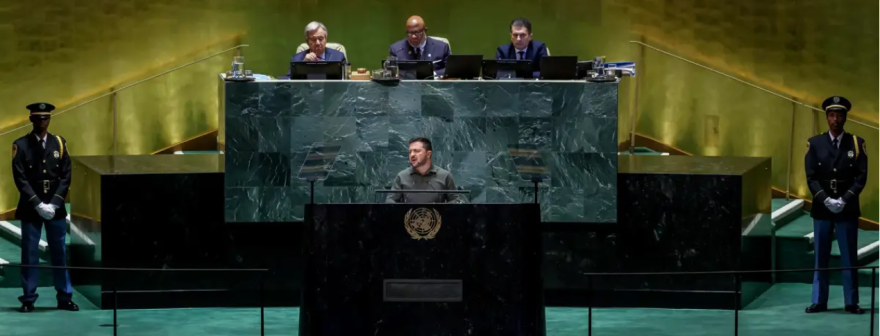
Like every year since 2014, and especially since 2022, Ukraine has thoroughly prepared the week in which world diplomacy meets at the United Nations General Assembly. With reproaches exchanged about the lack of decisive success in the summer counteroffensive, the main Western bet for 2023, the main objective of Zelensky's executive was precisely to maintain the centrality that the Ukrainian issue acquired a year and a half ago. A prominence, which Kiev has achieved through a careful communication strategy and the favor of the Western media apparatus, willing to highlight Ukrainian suffering in a very different way from other more distant wars and in which the population is not European.
Managing to maintain that favor is the fundamental prerequisite to continue demanding the weapons and financing that make it possible for the Armed Forces of Ukraine to continue fighting and for the State to maintain at least part of its structure and its economy. In a war in which Ukraine claims to be fighting for its independence and sovereignty, the reality is precisely the opposite: kyiv's dependence on its partners is not only maximum, but growing. This implies the need to maintain the favor of Western countries and ensure that difficulties in the production of material and ammunition in European countries do not pose a supply problem and that war fatigue does not force Ukraine into a negotiation in which was forced to make a compromise.
Despite not corresponding to the correlation of forces or the situation on the ground, Ukraine has made it clear that the only result it is willing to accept is its complete victory, one in which the civil factor of the war is not taken into account. and there are no concessions of territory or rights to the population of those territories. Once again, Zelensky insisted on the idea that “all Russians” must leave Ukraine. It is possible that the Ukrainian president is referring only to Russian troops, although precedents suggest that it is not only that population but all those that identify with Russia that the Government wants to leave. Long before Russian troops violated Ukraine's borders, in a somewhat condescending way, Zelensky appealed to those people, “for the sake of their children,” to leave their homes and move to Russia. For a long time no one has hidden the goal of creating a purely nationalist Ukraine.
Even then, the intentions were clear. Now, the war has given Ukraine the unconditional support that it had been demanding for years to resolve the conflict, which precedes the arrival of Russian troops, unilaterally, without any commitment or concession. Ukraine's actions in the Minsk process are sufficient indication of the authoritarianism of the Ukrainian authorities. During the seven years of talks, Kiev never took steps towards the implementation of the road map, which it always considered unacceptable for not resolving the Crimea issue and for seeing the cultural, linguistic and political rights to Donbass as an unaffordable concession. The reality is that this minimal cultural autonomy destroyed the possibility of creating a unitary Ukraine, centralized and with nationalism imposed from above in the regions that have rejected it. The commitment, even when the counterpart was the recovery of the territory, was always beyond doubt. The war with Russia has significantly facilitated the Ukrainian narrative, which even before 2022 was based on the Russian aggression , but with the generalization of the conflict to the entire country has meant the arrival of the unconditional support that Kiev had been demanding for years.
That centrality that the war has acquired in Ukraine, which has left no room for other wars and other human suffering that occurs in places outside Europe, and the military, financial and political support that Kiev has acquired has also given it a sense of superiority in the ability to dictate the only acceptable terms for ending the war. For a State that absolutely depends on the constant and growing support of its allies, this arrogance is precisely the chosen strategy to continue demanding more support from its allied countries and also from those that are not. In the same way that the discourse of unity of the Ukrainian population, widely adopted by the press, prefers to forget the Ukrainian population that identifies with Russia and that has fought and is fighting against the Ukrainian Armed Forces,unity against the aggressor ignores that a large part of the countries on the planet have remained neutral. Among them are the two most populous countries, India and China, which have not only refused to impose sanctions on Russia, but have benefited from the economic opportunities brought about by Russia's need to redirect its products to markets far from its home country. traditionally a priority European market.
However, none of this prevents Ukraine from continuing to exploit the discourse of full national and international support for Ukraine. “Despite the differences of vision, the world is united in basic things: Russia has to lose, the reestablishment of the territorial integrity of Ukraine is imperative to the restoration of respect for international law,” he wrote, confusing the Western world and the world. , Mikhailo Podolyak after Zelensky's intervention. Hours earlier, the Foreign Minister of China, the second most populous country on the planet, had met with Sergey Lavrov in a meeting in which both agreed that the war cannot be resolved without taking into account Russian demands. What's more, a large part of the existing peace or negotiation proposals take into account issues such as Crimea,
None of that matters either to Ukrainian politicians or to the press that supports them. “Zelensky calls for unity in dramatic speech at the UN,” headlined CNN after the Ukrainian president's appearance at the United Nations General Assembly, in which he used each and every one of the main points of the Ukrainian narrative to demand more military aid to Ukraine and more sanctions and isolation of Russia. However, somewhat strangely, the Ukrainian president opened his speech with an unexpected note referring to nuclear weapons.
Zelensky, who although praised the non-proliferation strategy, also stated that “it should not be the only strategy to protect the world from this final war.” As the Ukrainian film director and nationalist activist Oleh Sentsov did in the past in his acceptance speech for the Sakharov Prize - a person who, it must not be forgotten, had fought for the elimination of nuclear weapons -, the Ukrainian president recalled, without much subtlety, Ukraine's nuclear renunciation. In a clear tone of reproach to his allies for forcing Kiev to renounce nuclear weapons that were not even its own but those of the Soviet Union and later Russia as a successor state, Zelensky stated that “Ukraine renounced what was the third largest nuclear arsenal. biggest in the world. At that time, "The world decided that Russia must become the guardian of that power." In reality, the codes for that weaponry were in Moscow, so that arsenal would have been useless without the transfer of those mechanisms, something that could even have been considered nuclear proliferation. Even so, Zelensky insisted in his speech that "history has shown that it was Russia that deserved nuclear disarmament most, back in the 90s. And Russia deserves it now, terrorists do not deserve to have nuclear weapons," the president stated. Ukraine in what appears to be a first step to suggest to its partners the installation of nuclear weapons on its territory as a defense. This is not the first time Zelensky has hinted at Ukraine's nuclear aspirations,conspiracy theory of the West, always ready to blind itself to the authoritarian and tremendously belligerent tendencies of its Ukrainian proxies.
In his speech, and in his subsequent media appearances in the United States, in which he has repeated ad nauseam that “evil cannot be trusted,” Zelensky also introduced other common aspects, such as deportation .of children - Ukraine has described as deportation, for example, the transfer of boys and girls from Donbass to spend the summer in Belarusian camps - the idea of using hunger as a weapon and the use of nuclear power plants as an element of blackmail. In a great projection exercise, Zelensky accused Russia of causing hunger in the third world with the blockade of Ukrainian grain which, as we have known thanks to data on shipments made during the year in which the Ukrainian Grain Initiative was in force, Black Sea, was mainly destined for countries like China, Spain and Turkey.
The third element, that of the use of nuclear power plants as an element of blackmail, is also, to say the least, curious. Once again Zelensky accused Russia of bombing the Zaporozhie nuclear power plant, the only nuclear power plant in Ukraine under Russian control and which has been bombed by Ukraine precisely to create a situation that would make its defense unviable. The hypocrisy of the Ukrainian president in this regard is blatant. However, with a televangelist tone similar to that of his boss, Joe Biden, who stated that “the road ahead will be long and difficult. But if we persevere, we will prevail. If we keep the faith, we will show that it is possible.” Empty speeches that only seek to maintain the status quo and force all those countries that have distanced themselves from Ukraine's intention to expand the war to the maximum to comply with the official version, an extreme simplification of the war in which good faces evil.
https://slavyangrad.es/2023/09/21/ucran ... more-28182
Zelensky's trip to North America and the state of the war
POSTED BY @NSANZO ⋅ 23/09/2023

Far from the exaggerated expectations that Ukraine always maintains regarding its actions abroad, Zelensky's visit to the United States has lacked the halo of unconditional support, optimism and victory that the Ukrainian president projected on his previous trip to North America, which took place in a much more favorable time for Ukrainian interests. The reality of national politics and the timing of next year's election campaign, in which the Ukrainian issue will be used as an argument both for and against Joe Biden's re-election, make it increasingly difficult to repeat the virtually complete consensus that greeted Zelensky with a standing ovation in his previous appearance before the US Congress. For obvious reasons - Canada welcomes the most nationalist Ukrainian diaspora and,
That is, without a doubt, the great concern of Zelensky, who wanted to present the current war in his country as a turning point in world history, a moment in which the world must rise to the occasion and supply what the world asks for . proxy army ready to fight for everyone. Hence, presenting Ukraine as the savior of the Western world, or at least of Europe, continues to be one of the main arguments of the Ukrainian discourse, which must exaggerate its political and geopolitical importance in order to guarantee itself the weapons with which to continue the war.
In that narrative that Zelensky's entourage has created with so much effort, the idea of certain victory intersects with that of inevitable defeat in the event of not obtaining the required material, something that would result in a catastrophic sequence for the European continent. Cynically taking up the always false but useful domino theory, which in the Cold War was repeated ad nauseam to justify coups d'état, open or covert military interventions or support for far-right dictators to prevent the fall of countries into the Soviet orbit , Ukraine has created a tremendously simple narrative, but one that remains effective in achieving its objectives.
“Putin's list of countries to destroy was long,” Zelensky said during his visit to the United States. "Until very recently. If Ukraine fell, half of Europe would have been at risk of falling into Moscow's sphere of influence,” he added despite there being not the slightest indication that there was any truth to his claims. The objective was none other than to exaggerate an imaginary threat to further exalt the American effort.
Unlike Russia, which publicly raised aspects such as the denazification or demilitarization of Ukraine as objectives of its military intervention and which it has never really been able to explain nor is it close to achieving, Kiev has been able to create a narrative according to which it must become the center from the political agenda and must receive the necessary weapons to defeat what Zelensky has described this week as “second Hitler.” The interest of the great Western powers in waging a proxy war against a historical enemy, Moscow, has made it possible that this simple and fallacious speech has been enough to launch a machinery that has made it possible for Ukraine to achieve its objectives little by little. politicians.
Faced with the criticism that has been raised for years about the issue of corruption, the reforms that Ukraine had to carry out to even achieve the status of a candidate country for entry into the European Union, the media advanced last week that Úrsula Von der Leyen prepares changes to facilitate the country's accession to the Union. Ukraine's entry into the European Union, even despite not meeting the conditions that have been demanded of other countries, seems only a matter of time. The argument, the same one that Kiev intends to use for its accession to NATO, somewhat more difficult, especially due to the enormous destruction of the country, is that Ukraine has paid the price in blood to achieve that objective.
The war has also managed to accelerate the process of continental separation between Berlin and Moscow, something that both kyiv and Washington had been fighting for for years. The explosions in the Nord Stream, still to be resolved after almost a year of investigations, are nothing more than the most graphic reflection of the end of an era in which the dialogue between the two great countries of Europe translated into an economic relationship that was always considered a threat to the United States. Ukraine, aware of being a good tool in this objective of breaking political and economic ties, exploited - metaphorically and perhaps literally - that possibility to its benefit. She did it before Russian troops got involved in the war and, of course,
In this time, Ukraine has also obtained, although not as quickly as it had demanded, a large part of the weapons it demanded. In wartime in Donbass, their wish list was limited to Javelin anti-tank systems or Bayraktar drones and no heavy weapons or anti-aircraft systems had yet made an appearance. Although Ukraine has always claimed to be fighting Russia, the difference between its opponent in the Donbass war and the army it has faced since February 24, 2022 is notable. kyiv has managed to send Leopard, Challenger tanks and other Western armor, it has received a significant number of Soviet-made fighters - sent by the countries of the former Warsaw Pact, who have taken advantage of the option of sending this ideologically uncomfortable weaponry to be replaced by something more in line with the times - long-range precision artillery, Patriot anti-aircraft systems, depleted uranium ammunition and even cluster bombs. Much of that list was considered a red line at the beginning of the Russo-Ukrainian war and is now delivered without even the weapons prohibited by some of Washington's partners being considered controversial.
Despite the social tendency to quickly lose interest in any topic and the loss of the central relevance of the Ukrainian issue for months in 2022, Ukraine continues to provide good publicity for politicians and celebrities of all kinds who want to promote themselves. Hence, visits to kyiv continue to be a way to initiate mandates or mark important dates and Zelensky continues to receive invitations to attend all types of political forums. During his visit to the United States, for example, Volodymyr Zelensky received an award from the Atlantic Council, the same organization that during his election campaign presented his arrival to power as a danger. Those were the times when candidate Zelensky's commitment speech made him a possible pro-Russian. The Ukrainian president's visits also usually coincide with big announcements. In this case, it was to be expected that the head of state of Ukraine could celebrate Biden's success in convincing Congress to expand the already million-dollar supply of weapons by $24 billion, amounts that have practically equaled the military budget. Russian. Even so, and despite the constant attempt to present Russian troops as ineffective, poorly trained and poorly equipped, Ukraine has not yet managed to balance capabilities on the battlefield, something that is being observed in the counteroffensive in the south of the country.
This has caused the need to demand more efforts from its partners. Months ago, Antony Blinken stated that Ukraine already had the necessary weapons and training to defeat Russia. The almost four months of offensive and constant Ukrainian demands for increased supplies deny that possibility. Ukraine's tactic to convince the most reluctant sectors to continue a practically eternal supply of weapons has been on this occasion to praise the investment that its military spending in Ukraine represents for the United States. “American investments in Ukrainian security and the global protection of freedom are working. One hundred percent. "Down to the last cent," said the Ukrainian president before proceeding to demand, once again, more weapons and more quickly.
During his trip, Zelensky has not been able to obtain either the increase in the budget for his army or some of the weapons that he had quickly demanded. These days, the United States has announced a new military assistance package to Ukraine - of a smaller amount than that announced a few days ago during Blinken's visit to Kiev - which highlights the arrival of the first Abrams tanks next week. kyiv will get more cluster munitions, anti-aircraft missiles and ammunition for its precious HIMARS. The White House's intention seemed not to be to announce the shipment of ATACMS tactical missiles, the latest wunderwaffewith which to defeat Russia in Crimea. Unblocking the delivery of these American missiles would also be the argument to pressure the German Government to deliver Taurus missiles to Ukraine, thus repeating the strategy with which Kiev got Olaf Scholz to agree to approve the shipment of Leopard tanks after the American approval of the future delivery. of their Abrams (which have not yet arrived, compared to the German tanks, which arrived months ago and some of which have already burned on the Zaporozhie front).
The United States' refusal to send long-range missiles and the delay in training and sending Western aviation are two important setbacks to Kiev's strategy, since these are weapons without which it knows it is unable to fight for Crimea. It is possible that, in the event of greater success in the counteroffensive, which is still struggling to break the Surovikin line and delve deeper into Russian territory in Zaporozhie, those deliveries would have been unlocked more quickly. It is also likely that the attack carried out yesterday, when Ukraine hit the headquarters of the Russian Black Sea Fleet with missiles, possibly British, is an example of what Ukraine is capable of doing with the weapons it has at its disposal, an argument for demand from the United States what it still denies it. With actions like this,
Western interest involved a rapid Ukrainian offensive in which control of Crimea would be called into question. The failure, at least momentary, of that plan has forced Zelensky to insist again on the possibility of catastrophe for Ukraine and the world if the country does not obtain the required weapons. “If we don't get the assistance, we will lose the war,” Zelensky said, according to Senate Majority Leader Chuck Schumer. Ukraine's ability to change its discourse has been notable throughout this war. Depending on the needs and fundamentally as an argument to demand more weapons, kyiv went from denying the existence of casualties to warning of an unsustainable number due to the imbalance in artillery potential.
Now, after months of claiming to shoot down virtually all Russian missiles and drones, the need to draw attention to the issue of grain exports and prepare for possible attacks on energy infrastructure throughout the winter has made Ukraine show again the consequences of Russian missiles and demand more anti-aircraft ammunition from its partners. Likewise, Kiev is balancing between certain victory and the responsibility of its partners to avoid inevitable defeat, all in order to take the battle - not just sporadic attacks - to Crimea, the only political objective that Ukraine has not yet achieved. . For it, The Ukrainian proxy has not hesitated to be increasingly demanding and harsh with the countries that allow its army to continue fighting and provide it with the financing to pay the pensions of its elders. Yesterday, the Ukrainian Government described the latest US military assistance package as insufficient, more than 300 million dollars (to which we must add the more than 600 announced by Canada) which did not include the expected ATACMS. Minutes after that complaint, and after the attack on Sevastopol, the American media began to publish that the United States is now willing to send the missiles to Ukraine. kyiv continues its trend of demanding weapons from its partners until it achieves its objective.
https://slavyangrad.es/2023/09/23/el-vi ... la-guerra/
Google Translator
***************
Chronicle of a special military operation for September 23, 2023
September 23, 2023
Rybar
For several days in a row, Ukrainian formations have been carrying out massive attacks on Crimea . This time the port infrastructure of Sevastopol came under attack again .
The Ukrainian Armed Forces are gathering forces to the flanks of Bakhmut , preparing an attack on the city. There are battles near Kleshcheevka and Andreevka , but there are no changes. Russian troops also identified the first Swedish-made CV9040C infantry fighting vehicle in this direction, which they destroyed.
Positional battles in the landings continue in the Vremevsky and Zaporozhye sectors of the front. The enemy makes sorties from time to time in small infantry groups, but to no avail.

Missile attack of the Ukrainian Armed Forces on Crimea
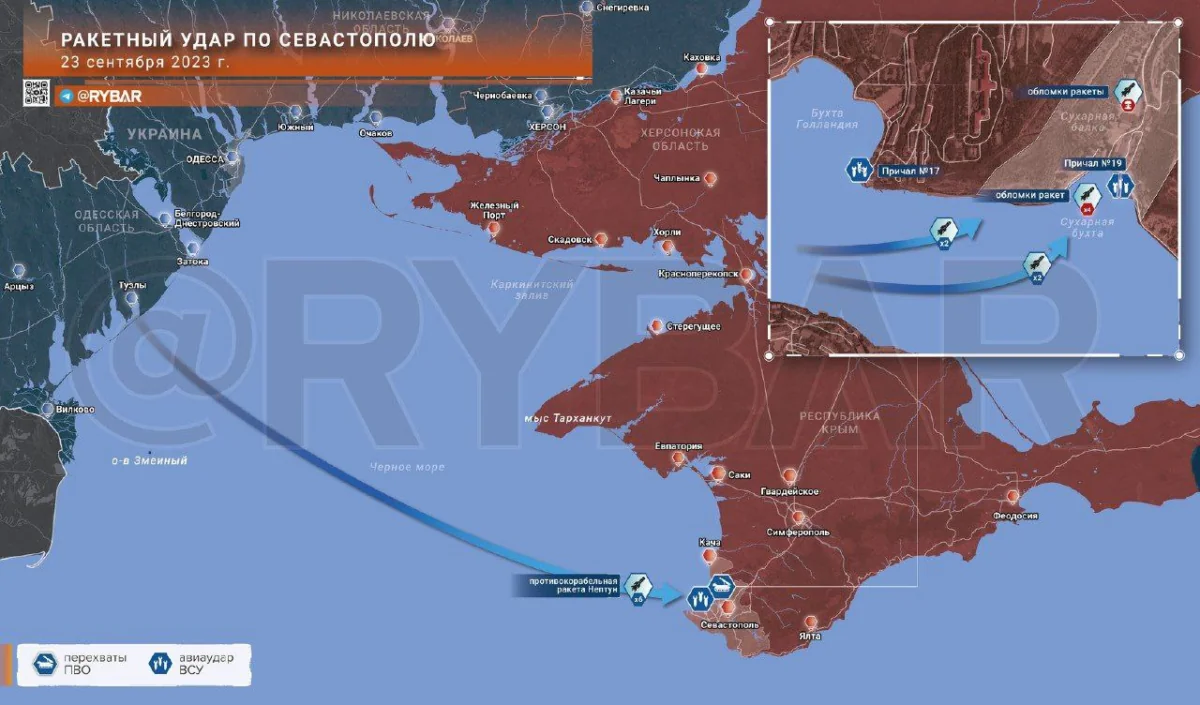
In the morning, Ukrainian formations again struck at the port infrastructure of Sevastopol . The enemy fired six Neptune anti-ship missiles from the Odessa region .
Berths No. 17 and 19 in the bays of Holland and Sukharnaya came under attack by the Ukrainian Armed Forces , which were hit by two Neptunes, and the targets were the ships that were stationed there and were subject to decommissioning. The extent of the damage is still unknown.
According to preliminary data, the remaining missiles were shot down by air defense units. The fragments of one of them fell on Sukharnaya Balka (on the Internet this was mistaken for flying across the territory).
The enemy's attacks do not stop. Judging by the choice of objects not only in Crimea , but also in the Kherson and Zaporozhye regions , the Ukrainian Armed Forces are pursuing the goal of disrupting control, command and communication systems.
Attempt to land the Ukrainian Armed Forces on a boat near Tarkhankut
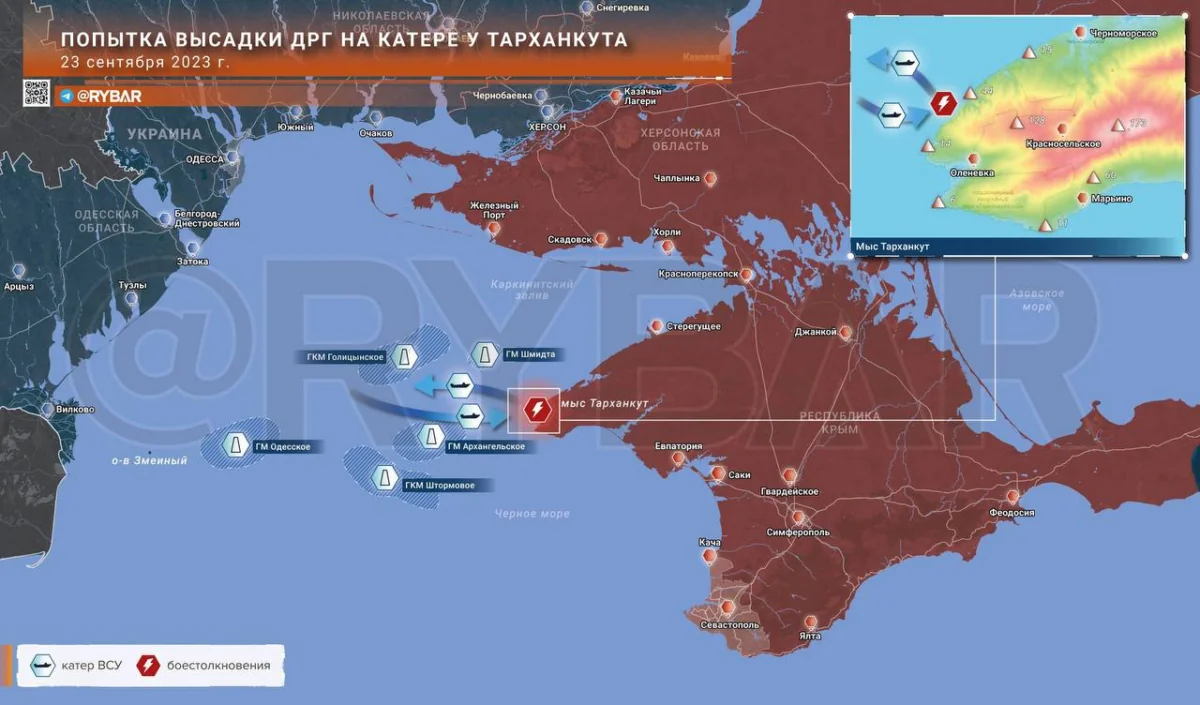
Last night an interesting incident occurred at Cape Tarkhankut , which until now had not been known. Under the cover of darkness, a Ukrainian boat with a DRG of the Ukrainian Armed Forces again tried to land troops on Cape Tarkhankut.
The speedboat moved along the coast towards Chernomorskoye at low speed: the bet was made on stealth. However, the group was discovered by our border guards: a fighter opened fire on the craft. A shooting fight ensued, and the DRG was forced to retreat. The boat was escorted by a drone almost to the Odessa region .
In this situation, the reaction of the serviceman, who immediately opened fire on the DRG, is encouraging. However, the question arises as to how the boat passed so far from the Ukrainian shores undetected, given that in recent times attacks on the landing force were carried out almost immediately after they left the Odessa region.
Either the boat was sailing in pitch darkness without means of navigation and communication, or it was using gas production and drilling rigs in the Black Sea to provide logistics for the boats. The infrastructure on the towers makes it possible to place not only weapons and equipment there, but also supplies to accommodate advanced groups.
Using them to their advantage to attack Crimea is more a fact than a theory. Do not forget that this happened immediately after the attack on the Black Sea Fleet headquarters in Sevastopol . All the sailors' efforts were focused on this, and the movement of the lone boat came as a surprise.
In the context of intensifying attacks on Crimea, such attempts to land and drop the DRG on Cape Tarkhankut , which is extremely convenient in this regard , will happen more and more often. Moreover, for many months the British intelligence services have been preparing the Main Intelligence Directorate and Special Operations Forces units specifically for the landing operation in Crimea.
The situation on the front line and combat operations

On September 22, 2023, Russian forces launched an attack on Kremenchuk . While the Ukrainian authorities urged citizens not to approach the impact site, chats were talking about what had landed at the amusement park. The Ferris wheel was indeed located nearby, but the area was hit by a shock wave.
At the address Gogol Street 2, open sources indicate a certain oncology clinic, which was deployed on the basis of a former military hospital and closed in 2008. Back in 2014-2015, the hospital was put in order, in 2016 the bunker and underground communications were updated , and photographs from 2018 quietly showed military equipment on the territory.
Members of the Ukrainian formations underwent recovery and rehabilitation in the hospital before returning to the front. It flew along them. To say that this is “the answer for Sevastopol” is somewhat incorrect, because military hospitals and clinics are no less important targets than headquarters and warehouses.
Exactly a year ago, we raised the topic of the justification of attacks on hospitals in Nikolaev and the Kharkov region : such actions sharply reduce the ability of the Ukrainian Armed Forces to restore combat effectiveness. There is no need to talk about any kind of mental anguish or conventions today: Ukrainians do not care at all about the death of the civilian population of Russia , and human rights activists work only for the benefit of Ukrainian propaganda, in every possible way forgiving them what is unforgivable to us.
I wonder how many adherents of the “we are not like that” ideology remain among Russians? Surely someone still thinks that we should play knighthood. Or not?
In the Starobelsky direction, fighting continues in the forests near Kremennaya . The artillery is working closely, destroying enemy positions and personnel. A similar situation is observed in the Sinkovka area .
In the Soledar direction, Ukrainian formations continue to fight for Kleshcheevka and Andreevka . The settlements themselves are in the “gray zone”, and the artillery and tanks of the Russian Armed Forces are actively working against enemy manpower.
Footage has appeared of an abandoned Swedish infantry fighting vehicle CV9040C near the Berkhovsky reservoir . The appearance of this type of armored vehicle in the Bakhmut direction indicates the transfer of a unit with the CV90 in service. Previously, Swedish vehicles were noted only in the Svatovsky sector , so this may be a unit that took part in the battles there.
Earlier we wrote that the forces of the 17th tank brigade of the Ukrainian Armed Forces were redeployed to Bakhmut . It was restocked with equipment and people near Kharkov , and it was there that most of the Swedish infantry fighting vehicles were delivered. So, quite possibly, the picture shows the first confirmed loss of the 17th brigade near Bakhmut.
Positional clashes continue in the Donetsk direction . Crews of the Tornado MLRS are working on the remains of the Ukrainian Armed Forces’ fortified area in the west of Marinka . In Avdeevka , the Russian Aerospace Forces targeted the location of the Ukrainian Armed Forces in the industrial zone with an air-launched X-38 missile, destroying enemy personnel.
The situation in the Vremyevsky sector remains stable: Ukrainian formations continue to make up for losses in manpower and equipment. The Armed Forces of Ukraine carried out sporadic attacks near Staromayorsky and Priyutny , but they did not lead to anything. Russian artillery, in turn, is actively working on enemy strongholds, preventing him from rotating.
There are also no significant changes in the Orekhovsky sector : fighting continues in the plantings between Rabotino and Verbov . Artillery and unmanned aircraft are actively operating along the contact line. Neither side is taking any active action.
The Ukrainian Armed Forces continue to transfer personnel and armored vehicles to the Kherson direction on the right bank of the Dnieper . An airstrike was carried out on one of these concentrations in the village of Lvovo in order to prevent the accumulation of enemy forces.
Shelling of rear areas and residential areas

The Ukrainian Armed Forces continue to regularly shell the border areas of the Belgorod region . Today, Vyazovoe and Novaya Tavolzhanka came under fire from the Armed Forces of Ukraine several times , and the Nekhoteevka checkpoint was covered with mortar fire . In the evening the shelling of Shebekino began . In addition, Russian air defense intercepted a UAV in the Belgorod area .
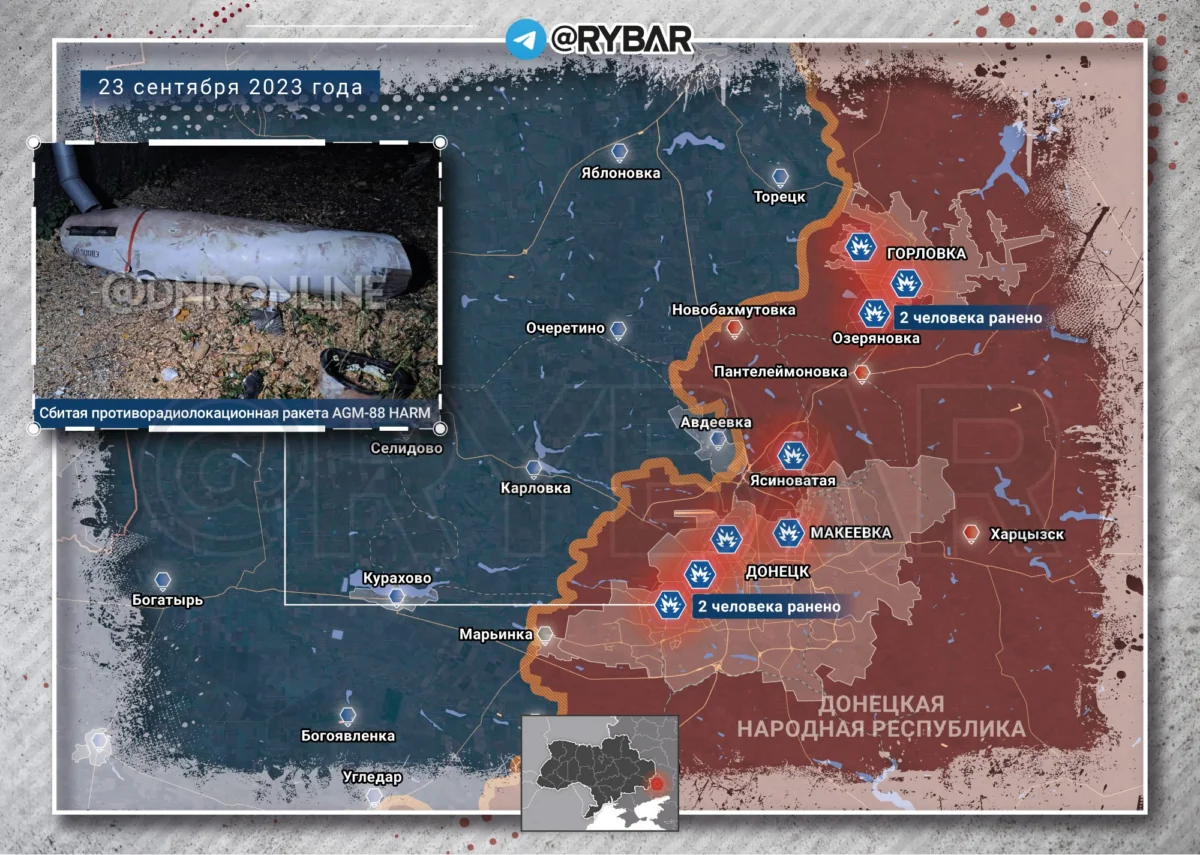
Ukrainian formations continue to shell populated areas of the DPR every day . In the Kievsky district of Donetsk , due to damage to transformers, more than a thousand subscribers remain without electricity, and residential buildings in Kuibyshevsky were damaged .
In the Kirov region, the air defense system was activated, an enemy AGM-88 HARM missile was shot down, two people were injured, and destruction was recorded on the territory of the kindergarten. The Ukrainian Armed Forces carried out strikes, including Yasinovataya , Gorlovka and Makeevka , two people received shrapnel wounds in Ozeryanivka .

Ukrainian formations continue to fire dozens of shells daily along the left bank of the Kherson region . This time, the civilian infrastructure of Kakhovka , Staraya Zburevka , Korsunka and Krynoki came under enemy fire . In Novaya Kakhovka, as a result of a mortar attack on a bus stop, one person was killed and another was taken to the hospital in serious condition.
In the Zaporozhye region in the evening, Ukrainian formations tried to strike Berdyansk , but air defense systems intercepted enemy missiles.
Political events
How will the American shutdown affect support for Ukraine?
On Friday it became known that the Speaker of the US House of Representatives, Republican Kevin McCarthy, was unable to bring up the party's defense spending bill for discussion. This happened due to opposition from the conservative layer of the Republican Party, which deliberately blocked the vote.
After the second attempt to pass defense spending failed, it became clear that a “shutdown” could occur as early as October 1 - a temporary cessation of the work of the US government that occurs when Congress fails to agree on funding for government activities. organs.
This circumstance has fueled rumors in the press and online that due to the suspension of government work, support for Ukraine will also be paused. This, however, is not the case. Yesterday, the Pentagon announced that it would continue to support Ukraine despite the shutdown, using the right to act in emergency situations.
In addition, as a safety net, during the break the United States will shift part of the responsibilities for supporting Ukraine to the “shoulders” of Europe . This is evidenced by the public statement of US Secretary of Defense Lloyd Austin , who called on the Europeans to supply the Ukrainian Armed Forces with more air defense systems.
Thus, this situation once again demonstrates that the United States is not going to stop supporting the Kyiv regime, at least under the current American administration.
About the supply of ATACMS missiles to Ukraine
Biden promised to supply Zelensky with a “Limited Batch” of ATACMS after the announcement of the next package of military supplies. The “ limited batch ” of ATACMS missiles numbers about 60 units and was delivered to Poland last month . Yesterday's news in Politico is only intended to legalize deliveries already made.
Another example of the legalization of already de facto arms supplies to Ukraine: The Wall Street Journal writes that Germany may transfer Taurus cruise missiles after the appearance of American ATACMS in the Armed Forces of Ukraine .
German long-range Taurus were delivered in a small batch by rail to Ukraine at the end of August , but the Ukrainian Armed Forces did not use them without the approval of Germany. And the information game in the media was needed in order to show how the Bundestag supposedly does not want escalation.
Now, having looked at the reaction of the Russian Federation (or rather, its absence) to the attacks on Crimea , Berlin decided that there would be no consequences for the country. And there is nothing to be surprised here. But if Atakms is more noticeable and easier to shoot down, then German missiles are essentially an analogue of Storm Shadow , which can hit a much greater distance. What this entails, we think, is unnecessary to explain.
In addition, the United States has appointed a special commission that will check the expenditure of American military assistance to Ukraine and control the allocated funds. The task force , led by Pentagon Inspector General Robert Storch, will operate in cooperation with USAID and the State Department .
Zelensky's statements about the elections
During his visit to Canada , Zelensky said that Ukrainian legislation allegedly prohibits holding elections during hostilities. According to him, it is impossible to ensure this now.
In fact, many observers believe that Ukrainian society, tired of fighting without much success and corruption, may simply not re-elect Zelensky . Moreover, many believe that he has serious rivals, including the Commander-in-Chief of the Armed Forces of Ukraine Valery Zaluzhny .
About the ban of the UOC MP
Speaker of the Verkhovna Rada Ruslan Stefanchuk commented on the possible legislative ban on the canonical UOC of the Moscow Patriarchate. According to him, it is unlikely that such a bill will now be able to gain a majority of votes in the Ukrainian parliament, although it was introduced in December last year. According to Stefanchuk, if this initiative comes to a vote and fails, this will give rise to information pressure from Russia.
Secret negotiations between Russia and Great Britain
British media write that Great Britain and Russia have been regularly engaged in dialogue on issues of nuclear and general security, and food shortages in the world for a year and a half since the very beginning of the North Atlantic Treaty Organization. Such meetings are held periodically on the sidelines of major international events.
British diplomats confirmed this information , saying that they never raised the topic of peace negotiations between Ukraine and Russia, as this is a matter for the Ukrainian authorities.
New strategies for Ukraine
The Economist published an article suggesting that Ukraine might be wise to try to freeze the conflict and restore its economy to something similar to the country's condition in 2014, when fighting was taking place in the east. Journalists believe that this can provide more room for maneuver and subsequent victory in combat operations.
However, they also admit that given the country’s collapsed economy and the flight or death of the male population, this may be unrealistic. Moreover, the scale of the conflict is incomparably greater than during the so-called “ATO”.
Other options in The Economist called a final freeze in hostilities or a sharp resumption of hostilities next year after increasing technical potential with the help of Western countries.
Lavrov's speech at the UN
On the sidelines of the UN General Assembly , Russian Foreign Minister Sergei Lavrov said that Russia is ready for peace negotiations on Ukraine, but is no longer ready to discuss an immediate ceasefire. In addition, the minister noted that the “peace formula” promoted by the Ukrainian authorities is unrealizable . This formula implies the return of Ukraine to the borders of 1991.
In addition, Lavrov noted that the Ukrainian part of the grain deal will resume as soon as obligations towards Russia begin to work.
Rybar
https://rybar.ru/hronika-speczialnoj-vo ... 2023-goda/
Google Translator
********
Damage to the naval headquarters building
September 24, 9:57

Satellite photographs of damage to the Black Sea Fleet headquarters in Sevastopol.
Repairing the damage and assessing the cost of repairing the building are ongoing.
https://colonelcassad.livejournal.com/8656633.html
Standing ovation for SS veteran
September 24, 14:23

Nazism in the West is no longer particularly shy.
In the Canadian Parliament, the veteran of the Waffen SS Galicia division was given a standing ovation.
(Video at link.)
https://colonelcassad.livejournal.com/8656784.html
(Many US liberals consider Canada an oasis of decency. It is of a piece...)
"Volga" in Zaporozhye
September 23, 9:30

In Zaporozhye, on the streets, local underground fighters began placing signs with the call sign “Volga” and the already known frequency 149.200, on which one can surrender.
According to current statistics, according to this frequency, more than 8,900 people have already surrendered. who chose life. The topic gradually seeps through the enemy’s information cap.


https://colonelcassad.livejournal.com/8653740.html
Google Translator

